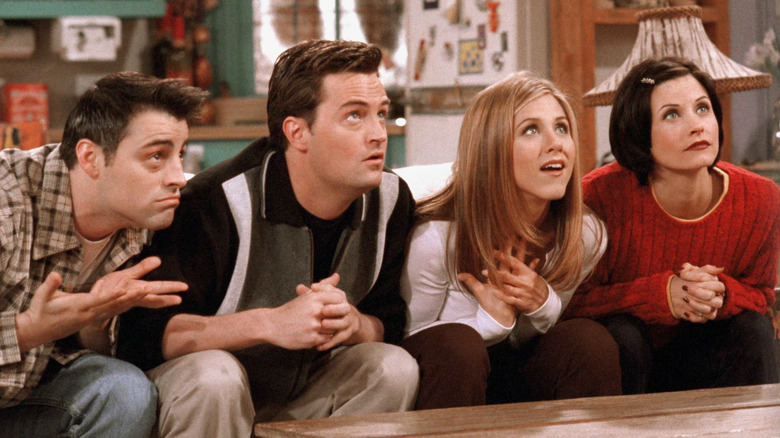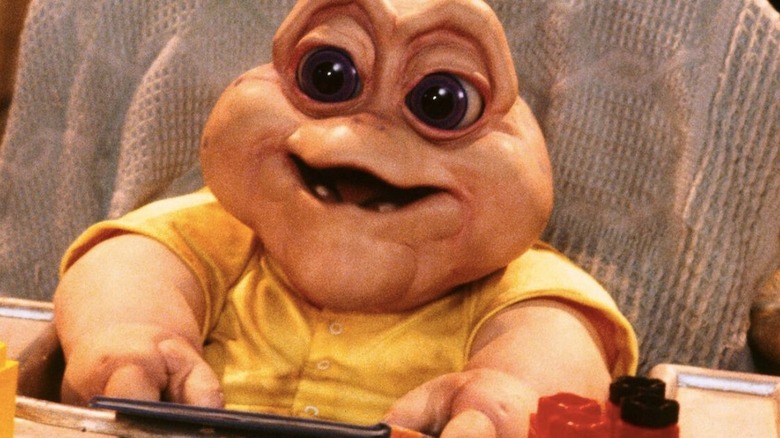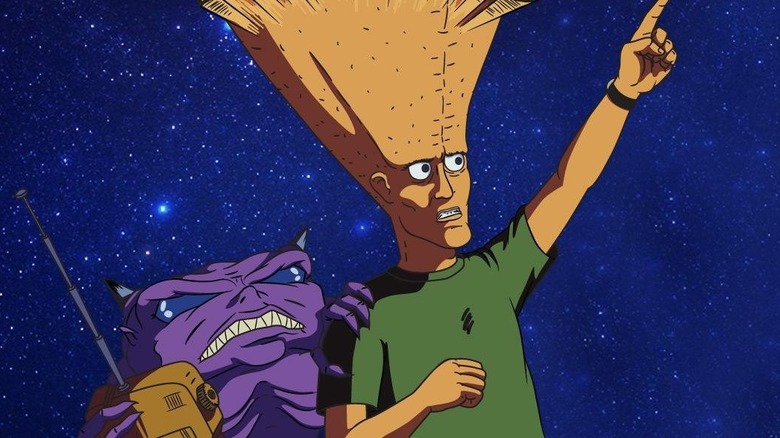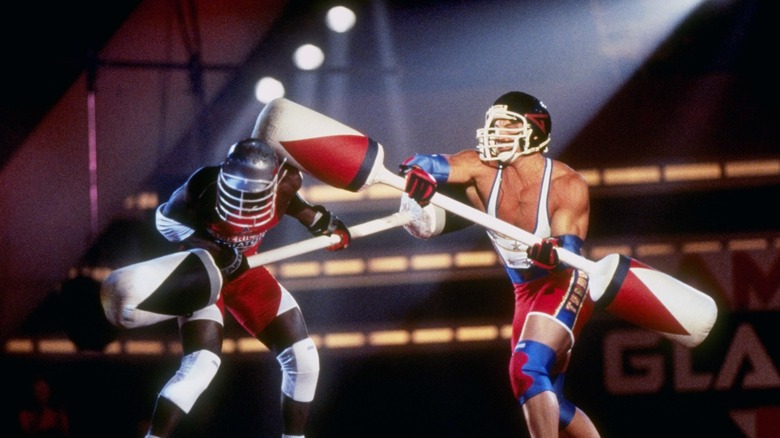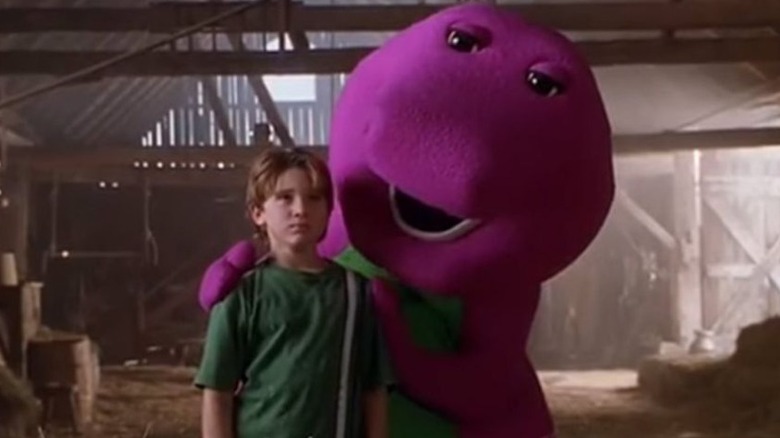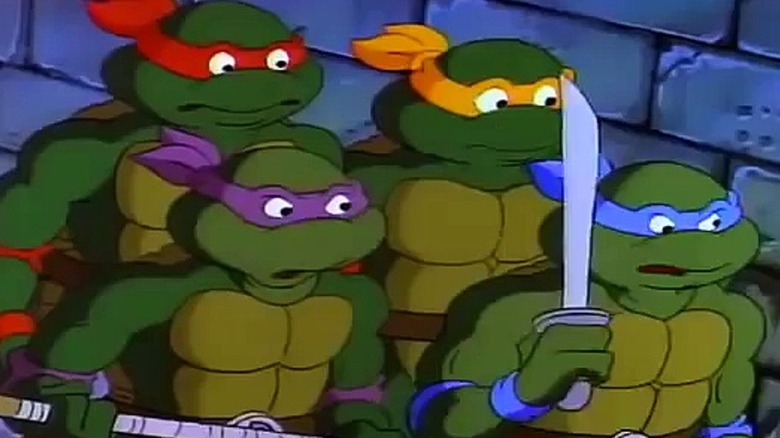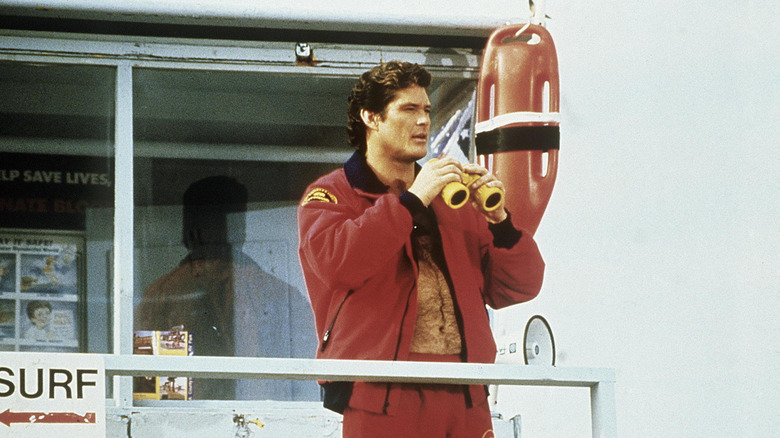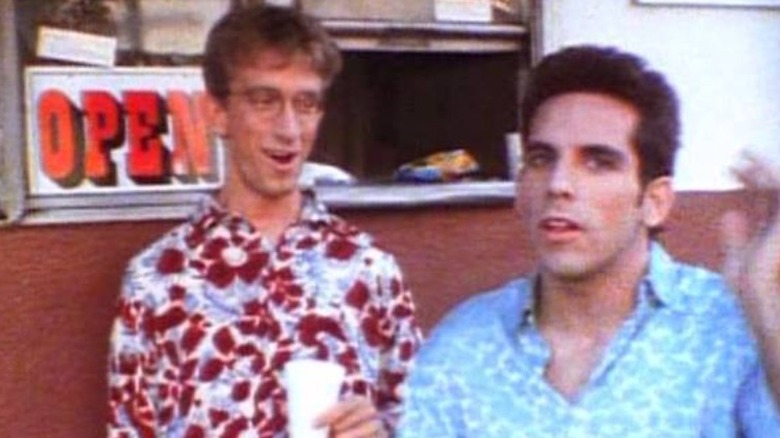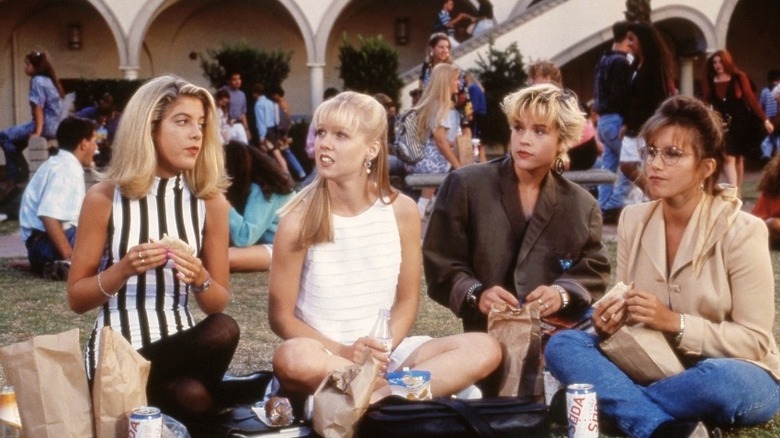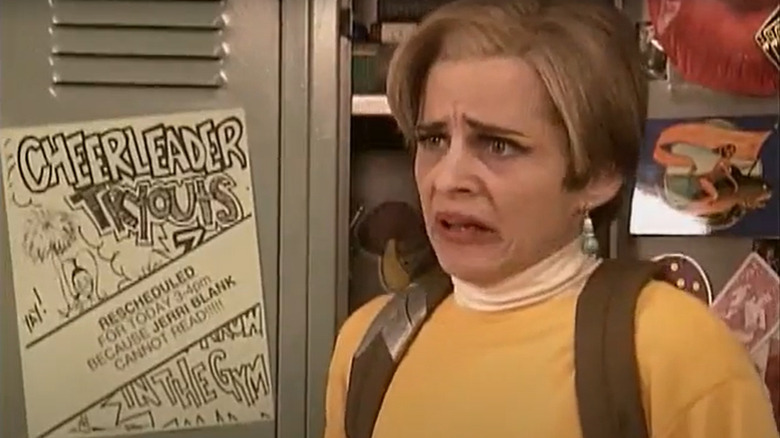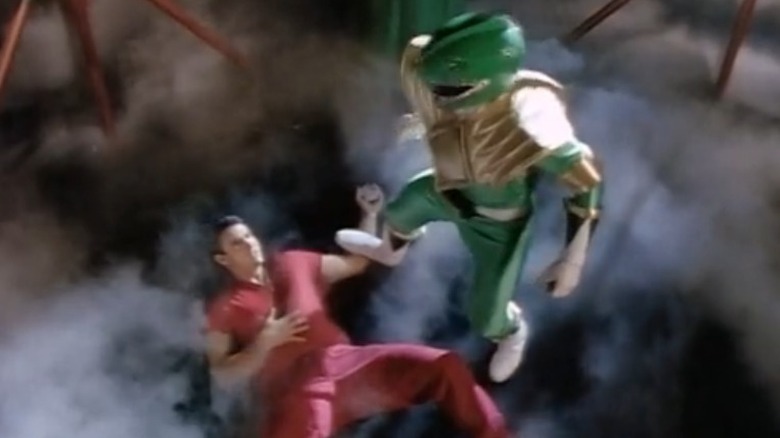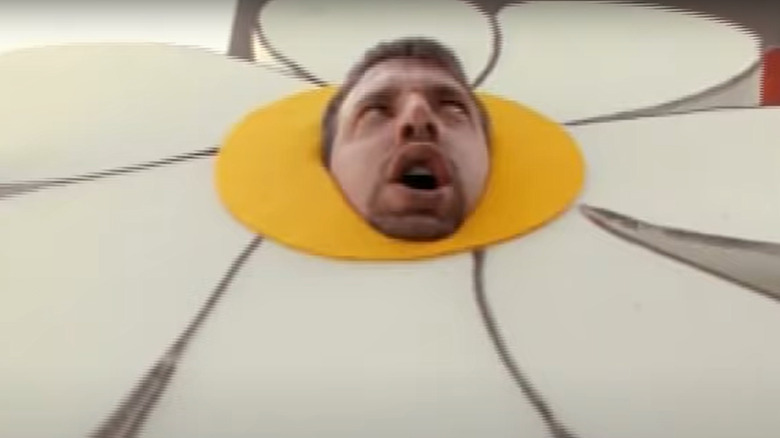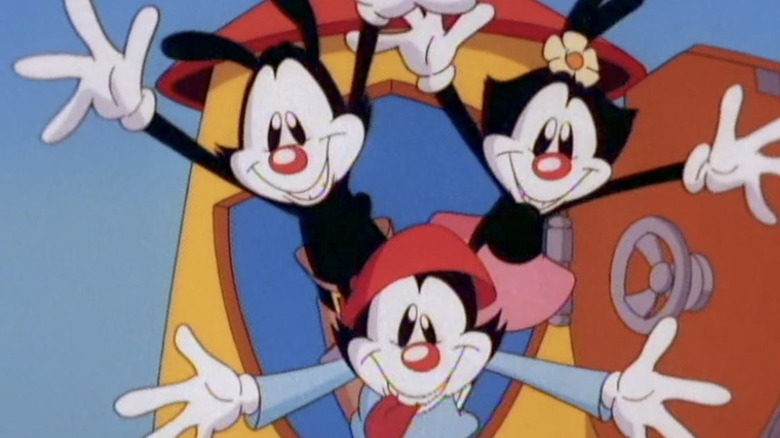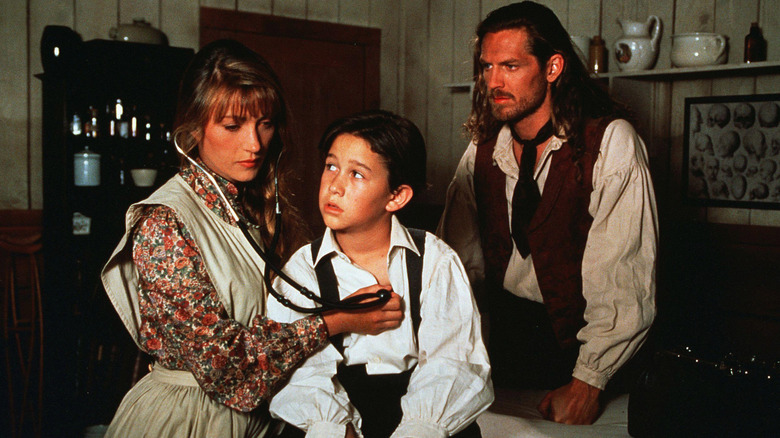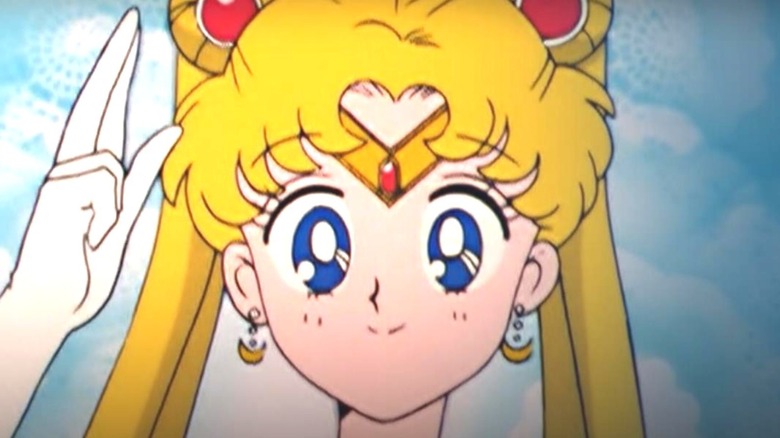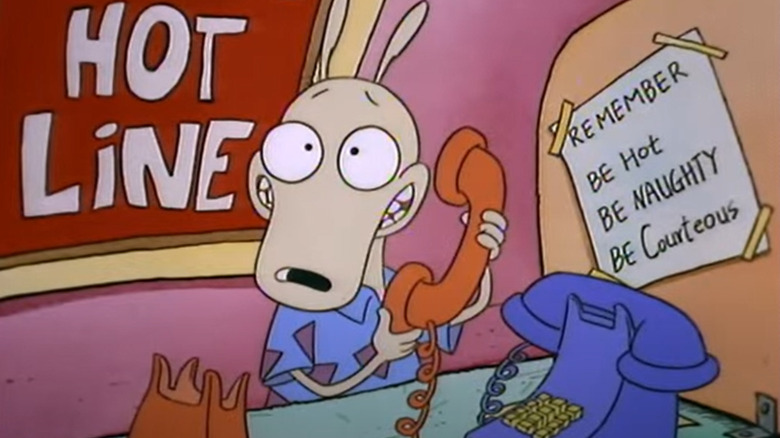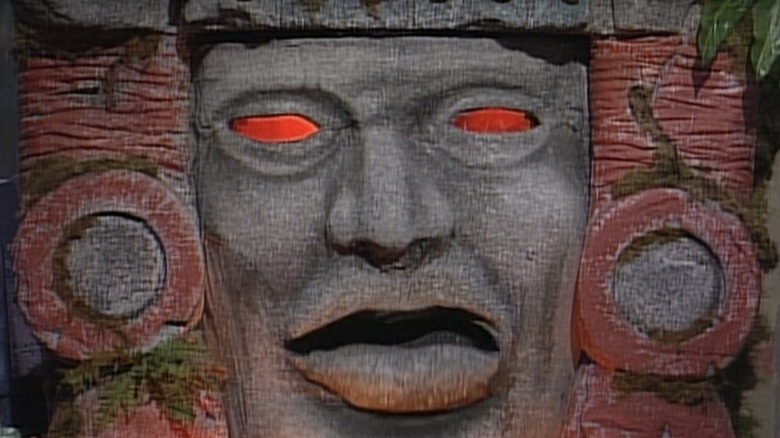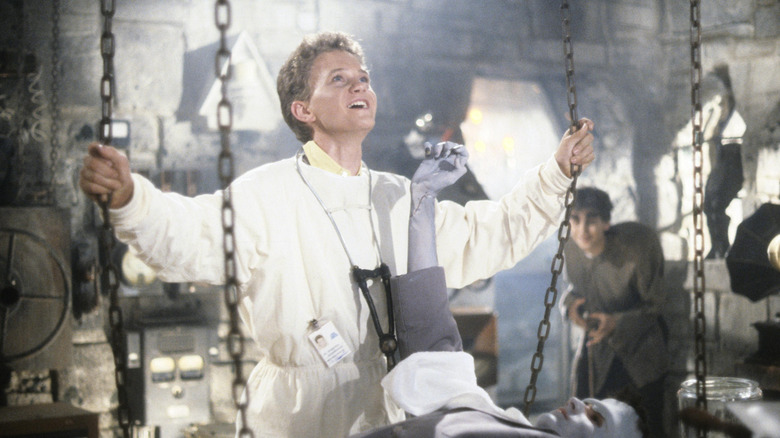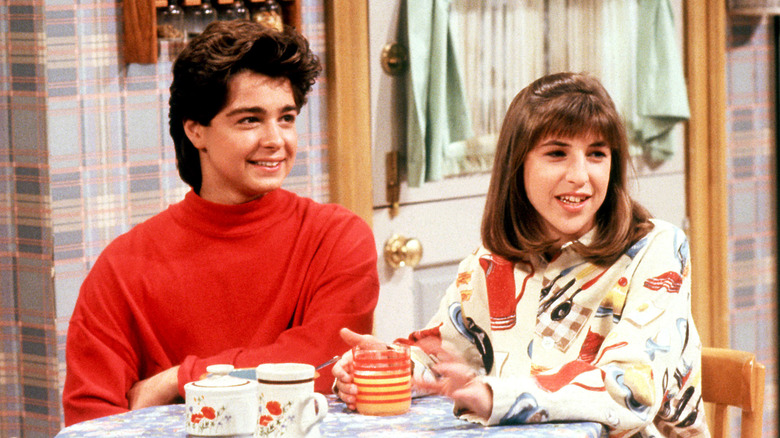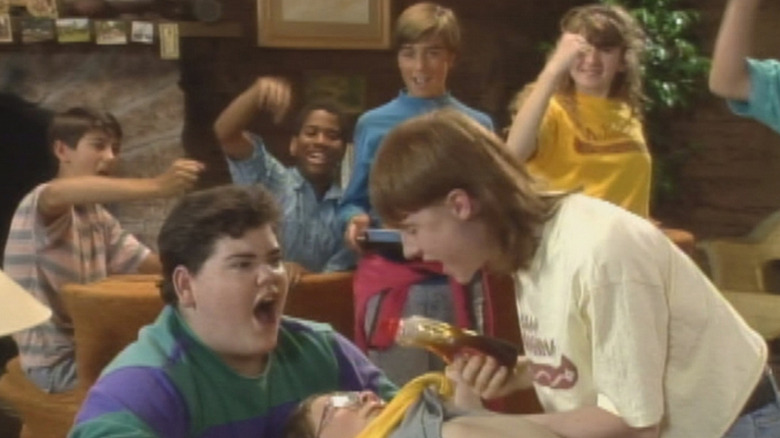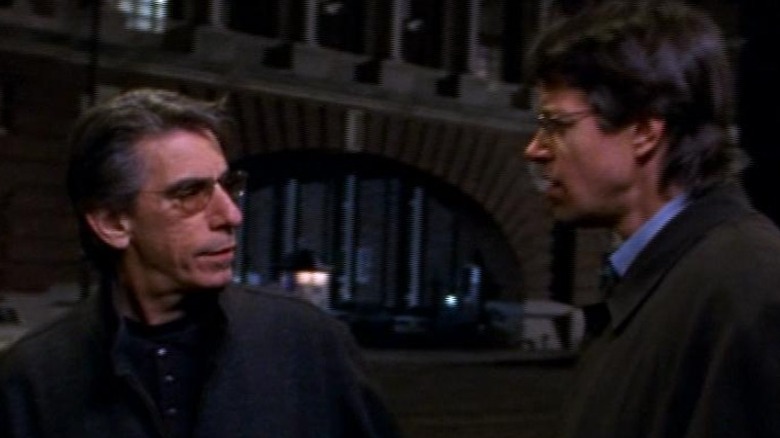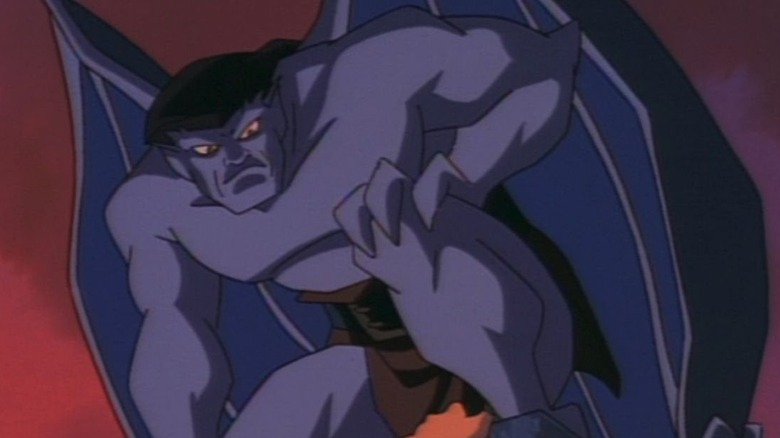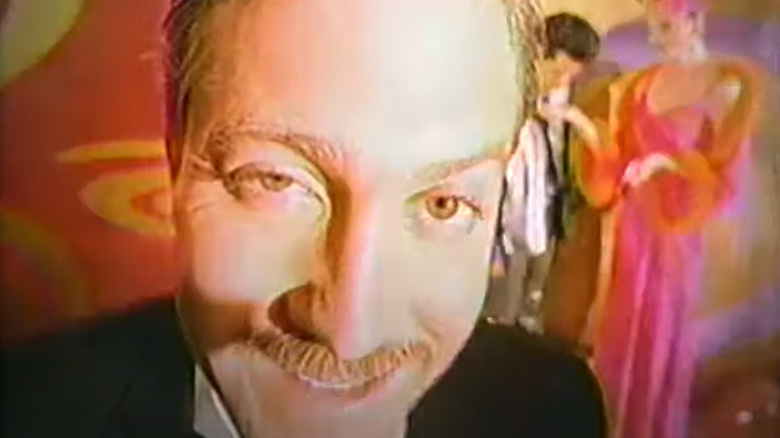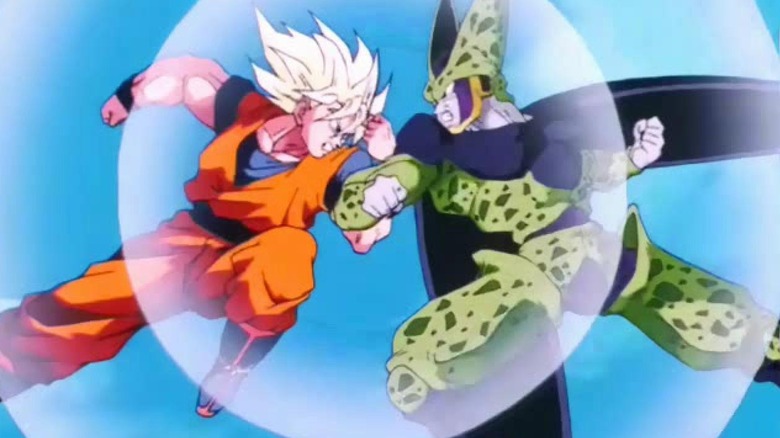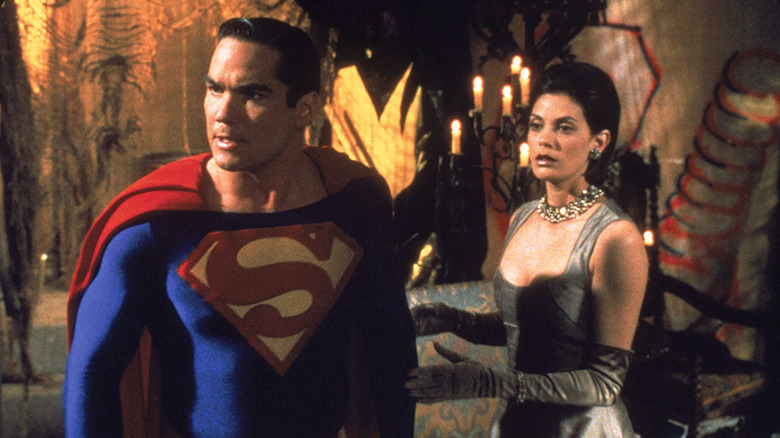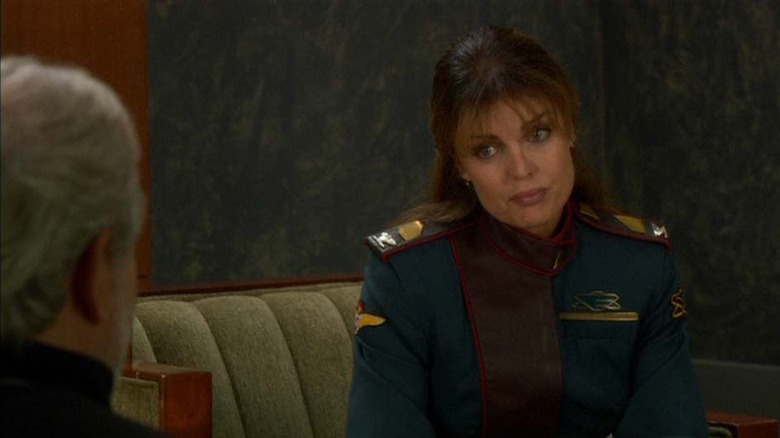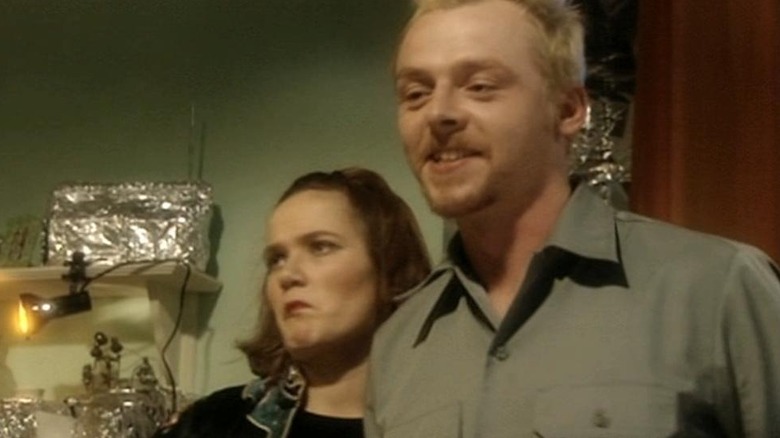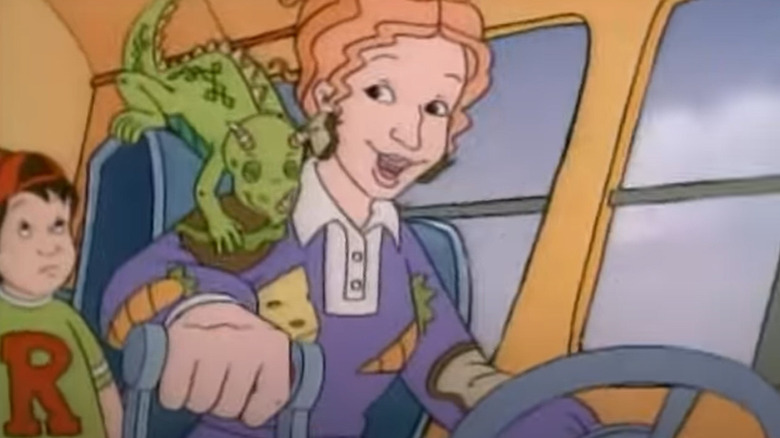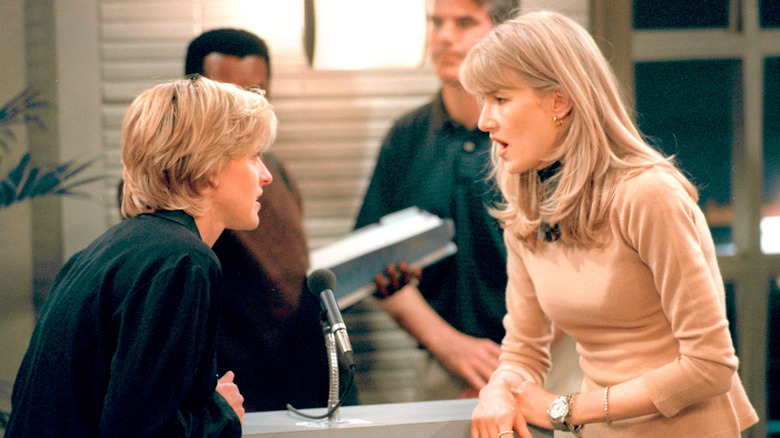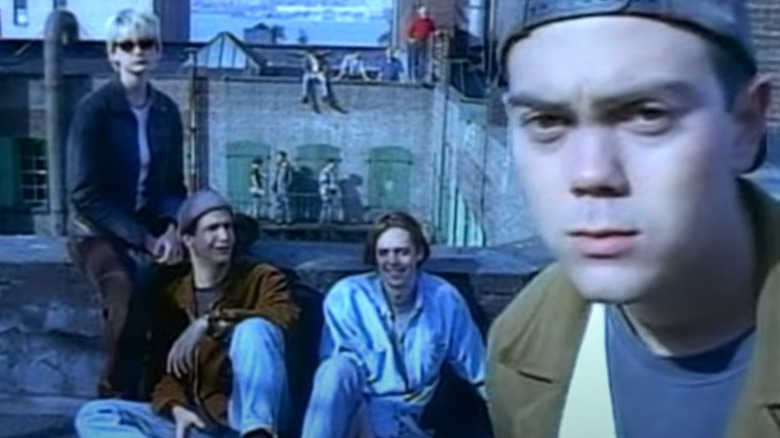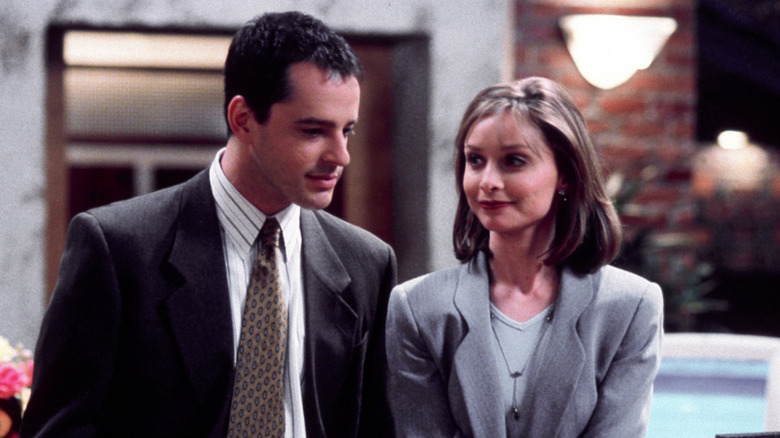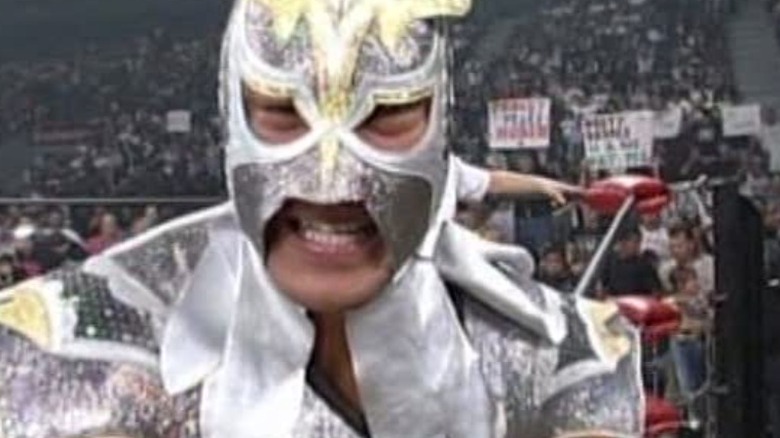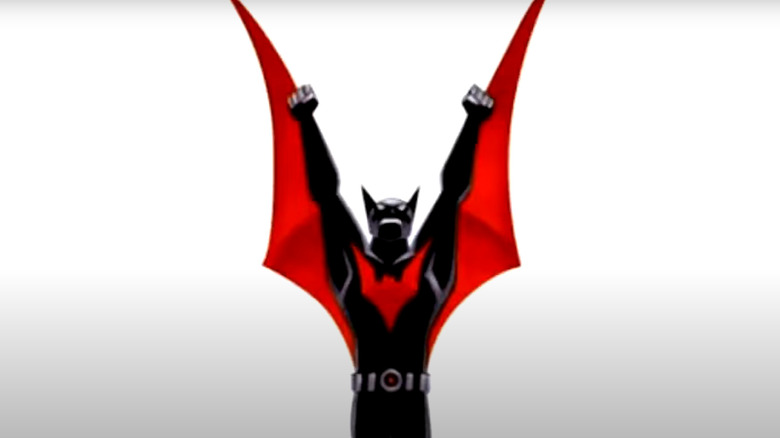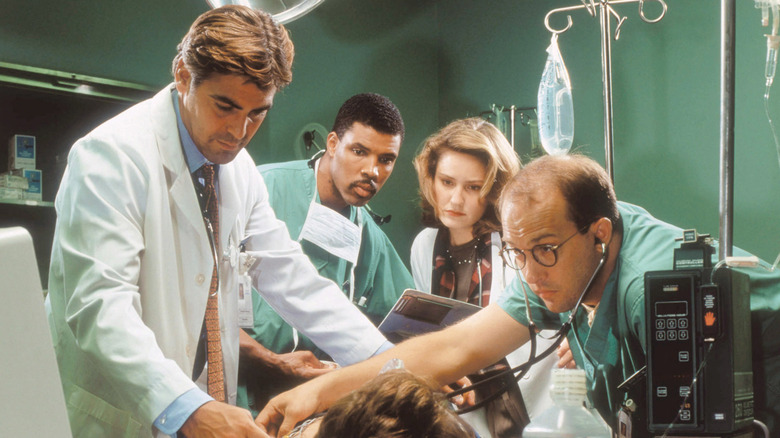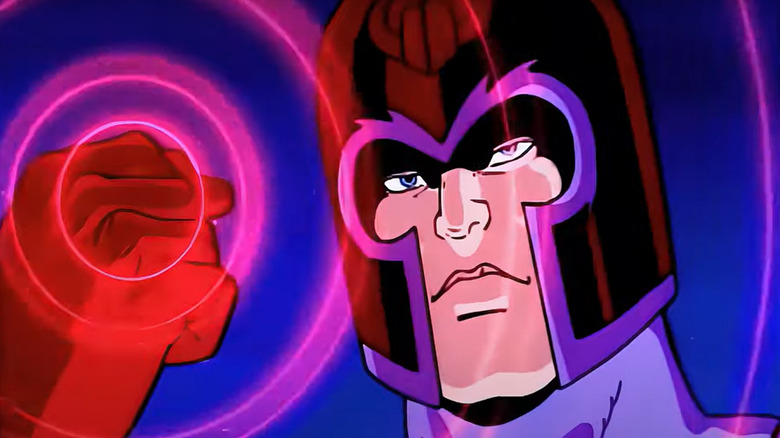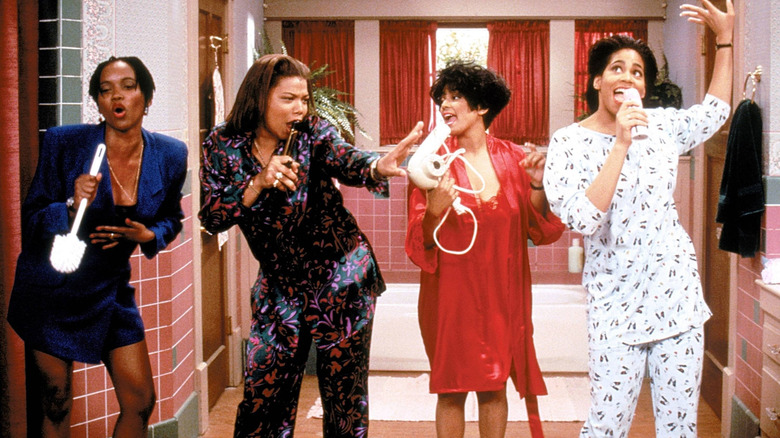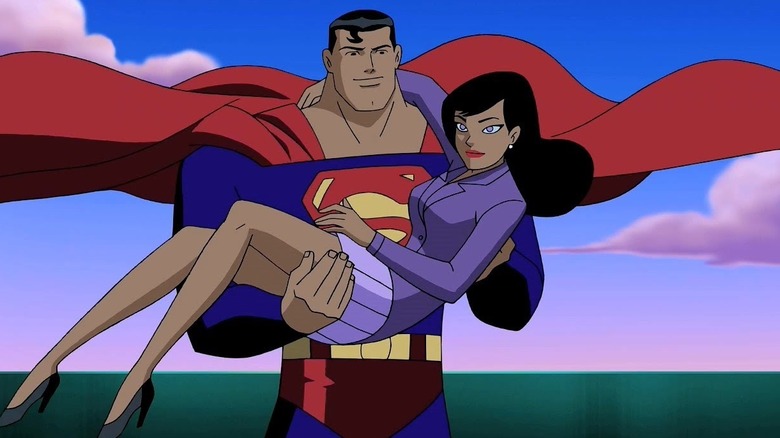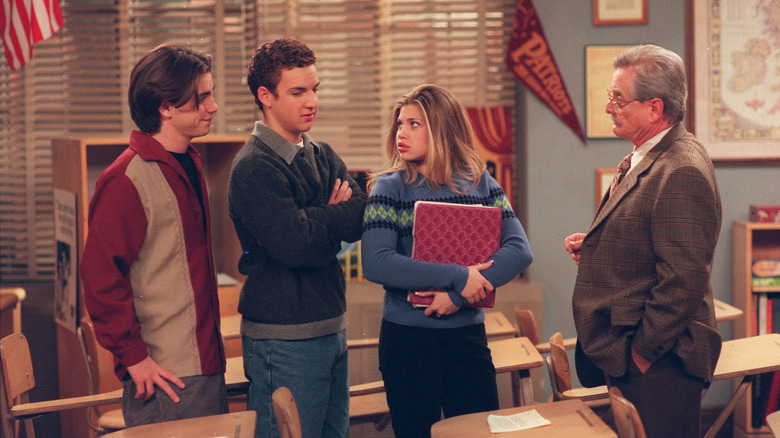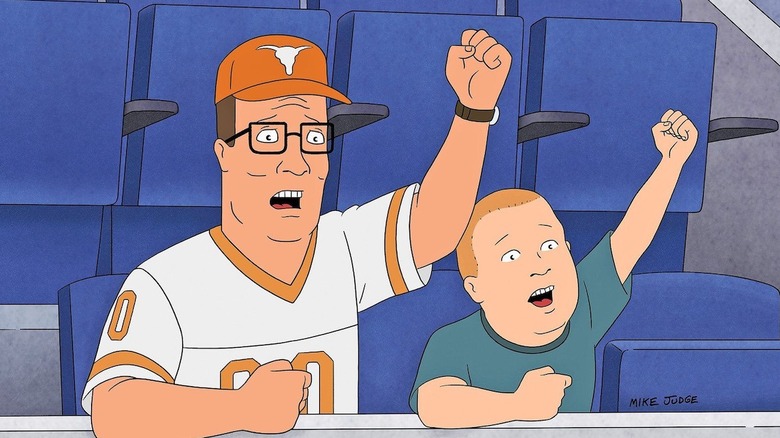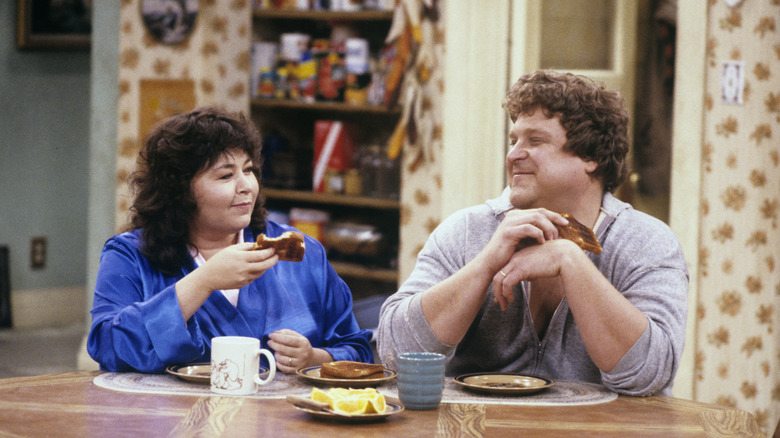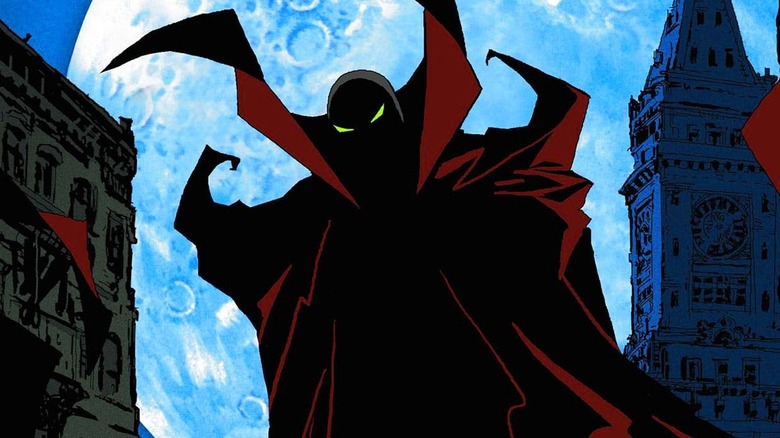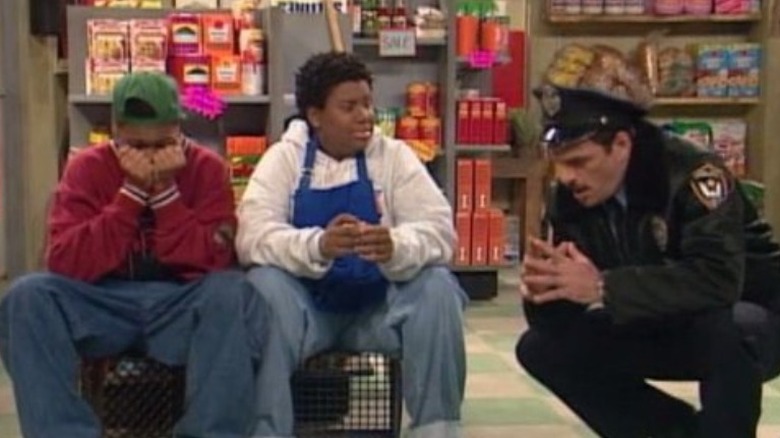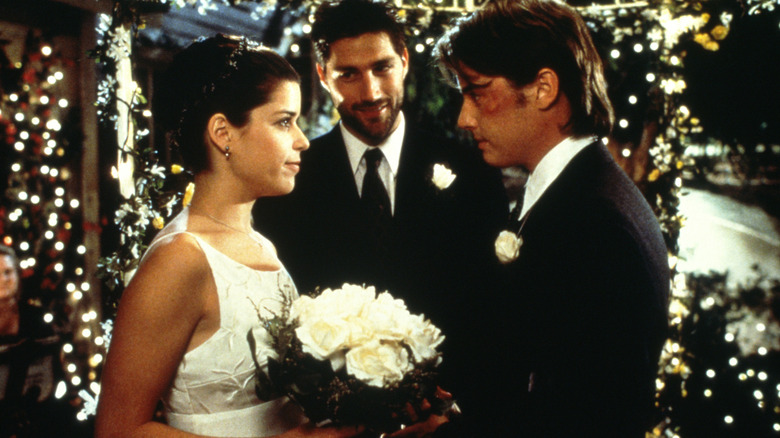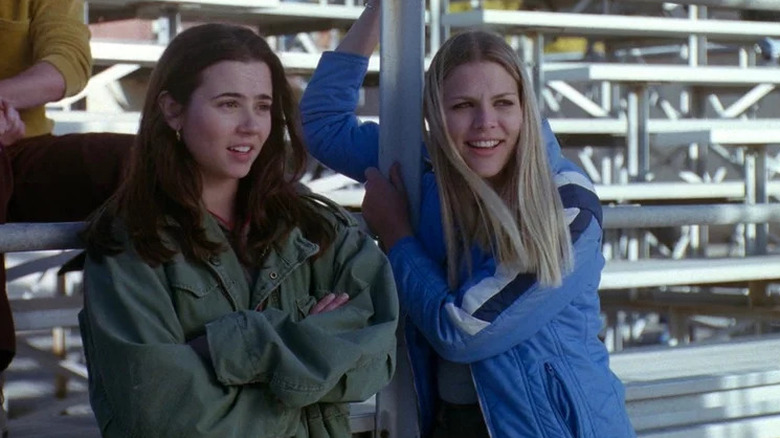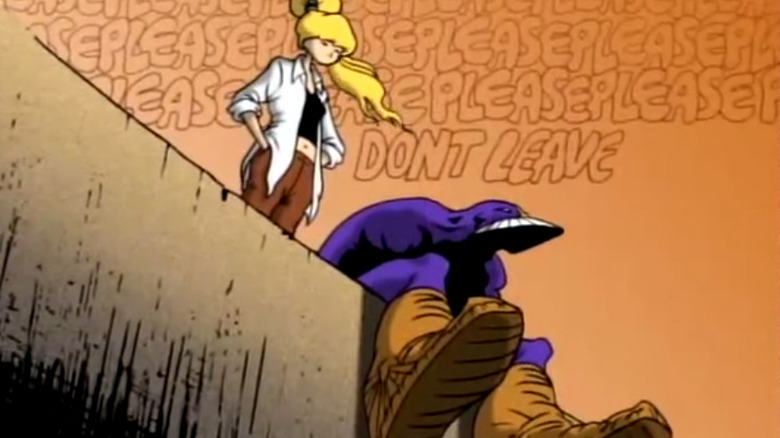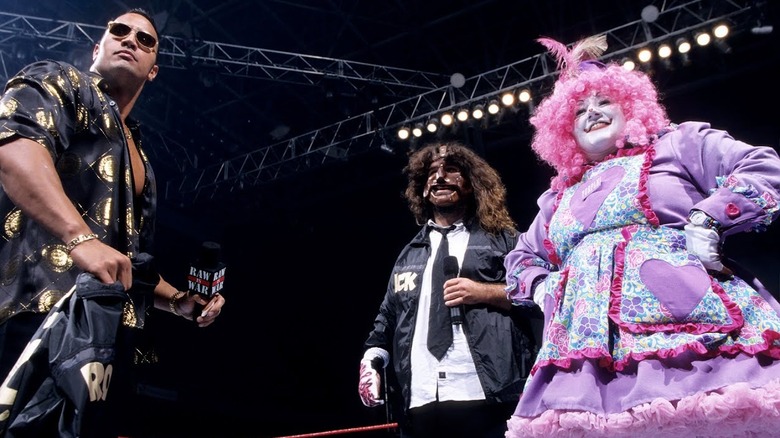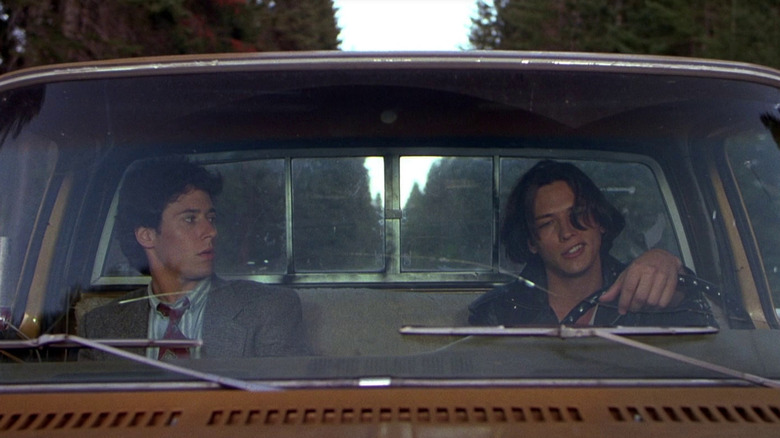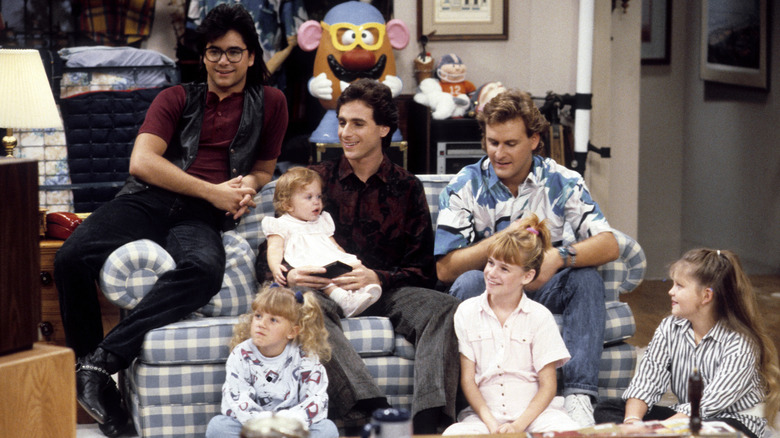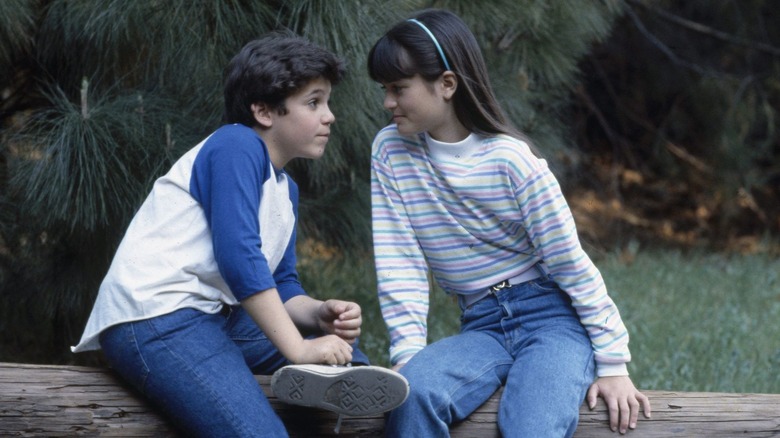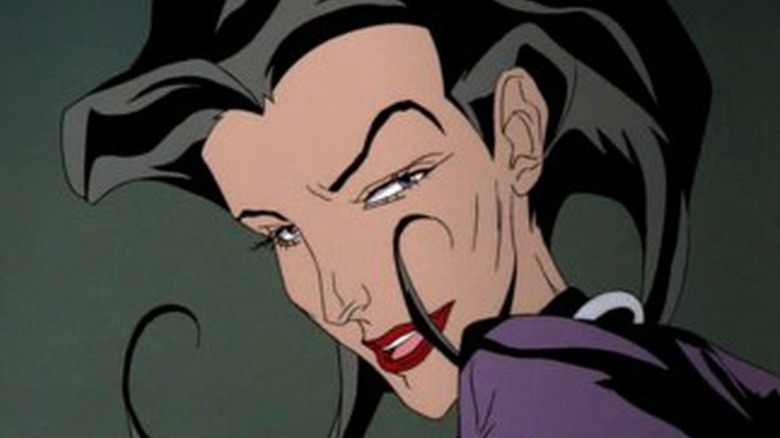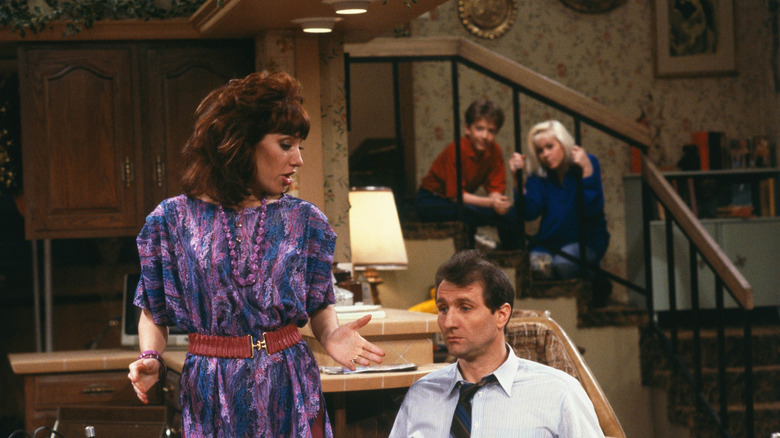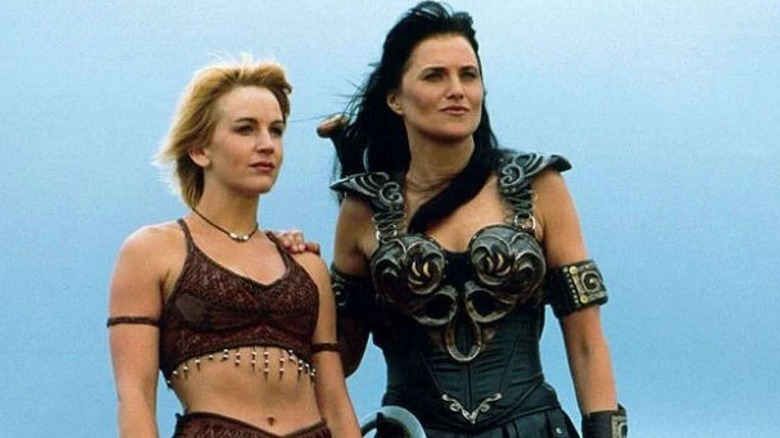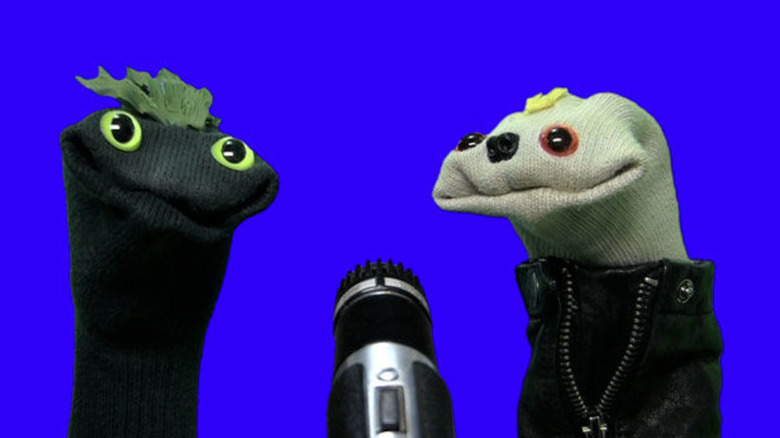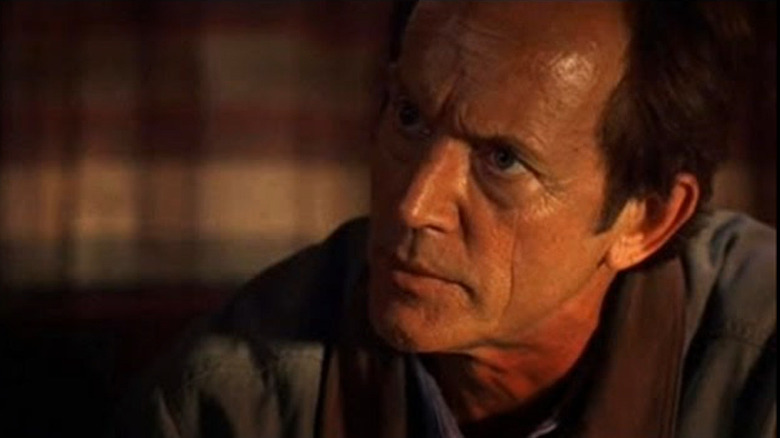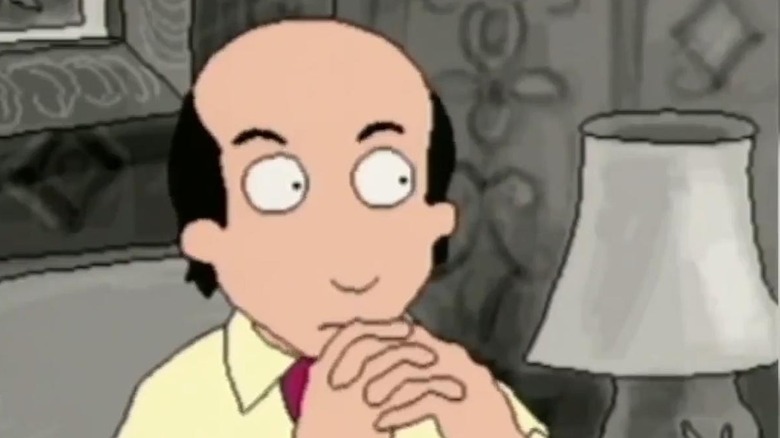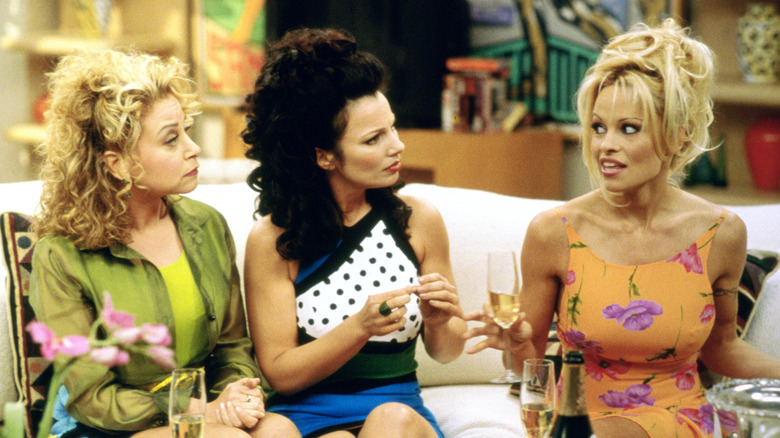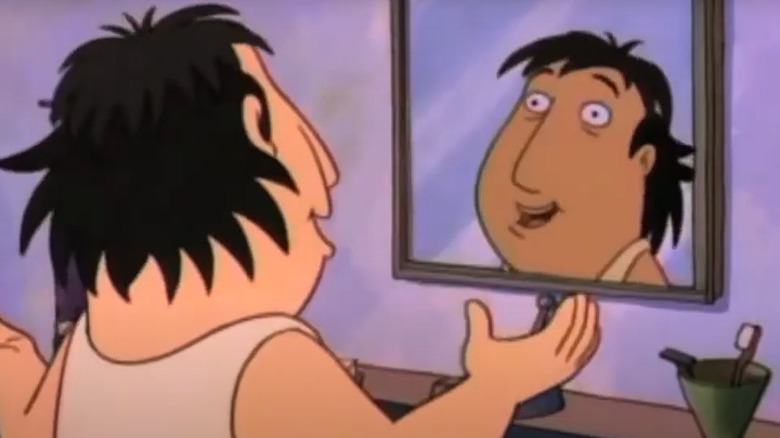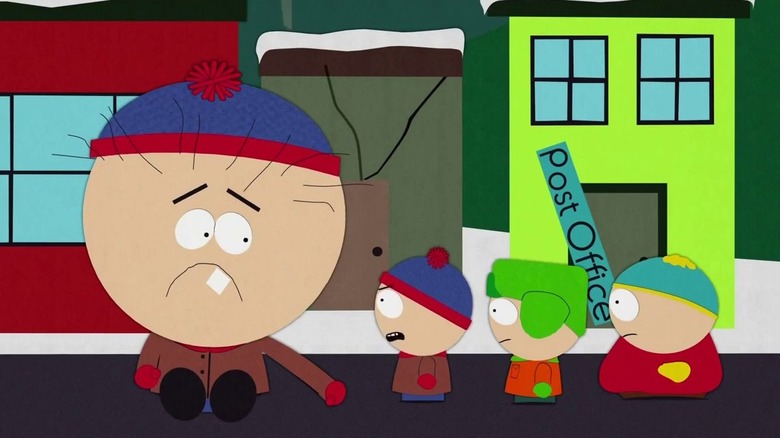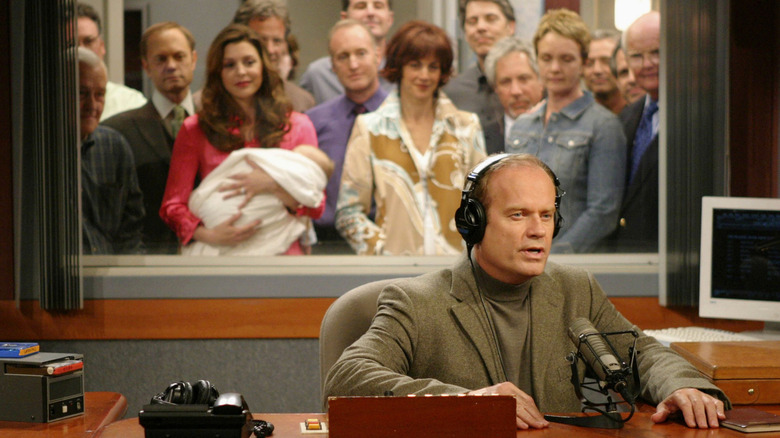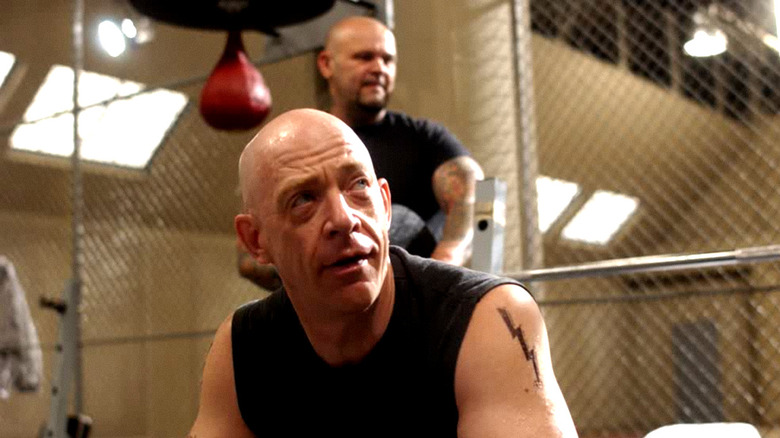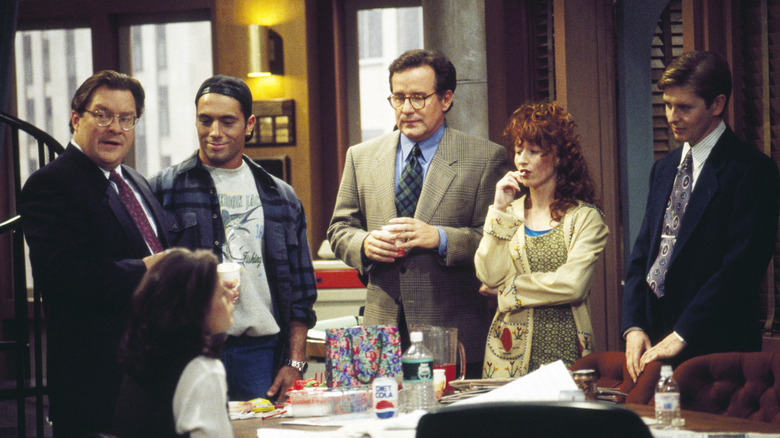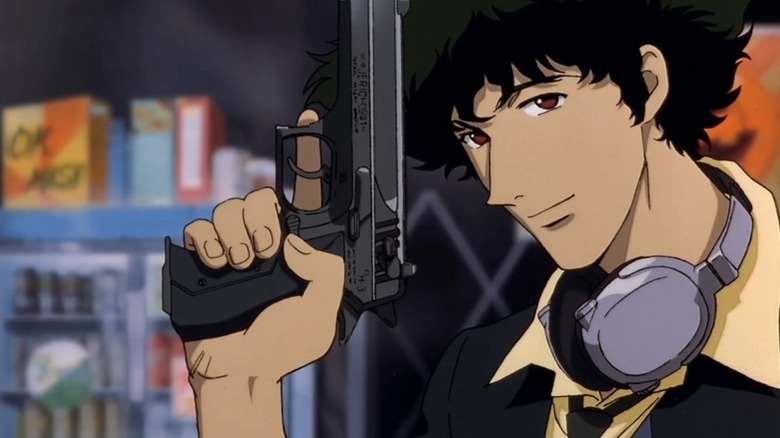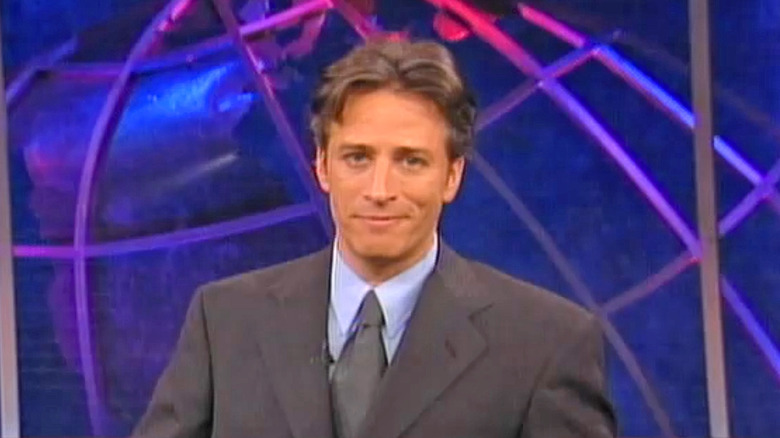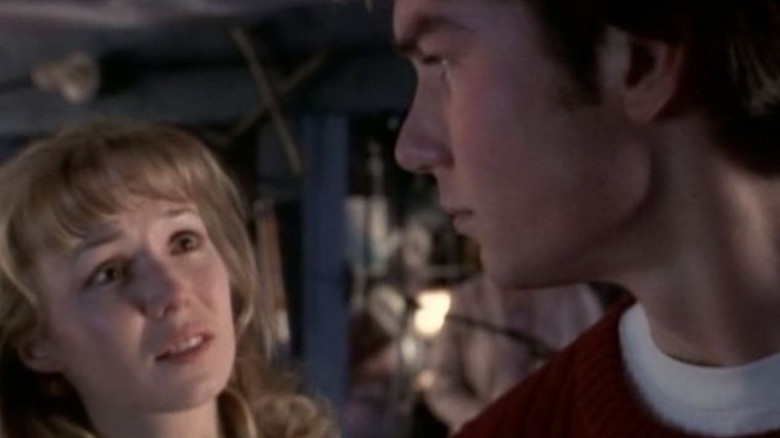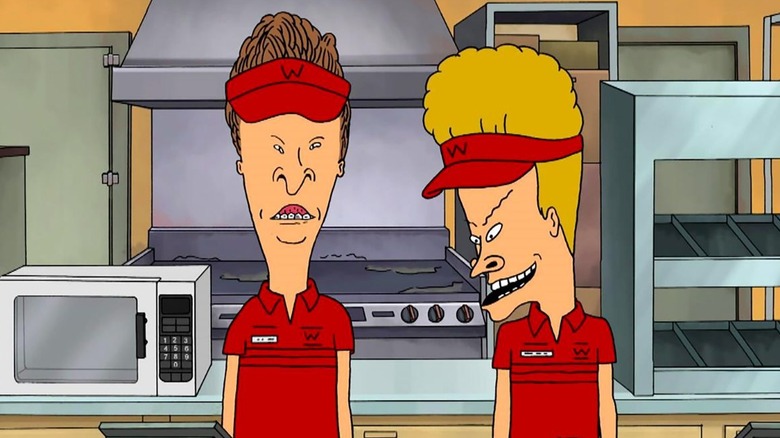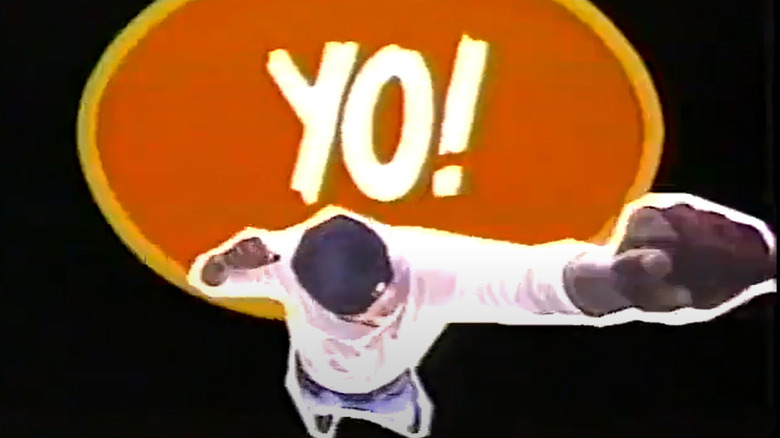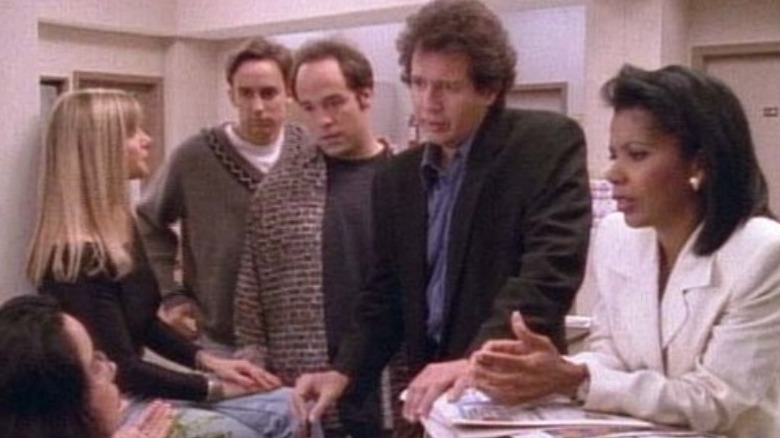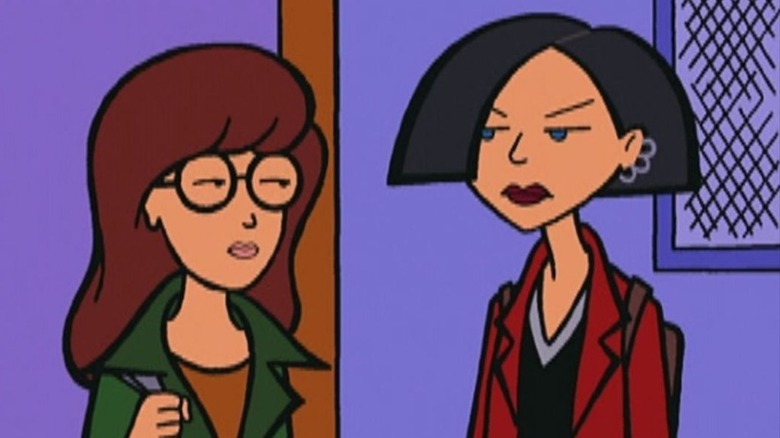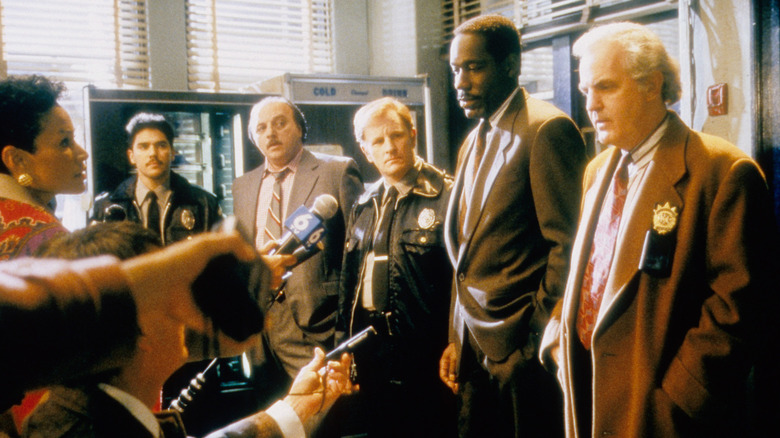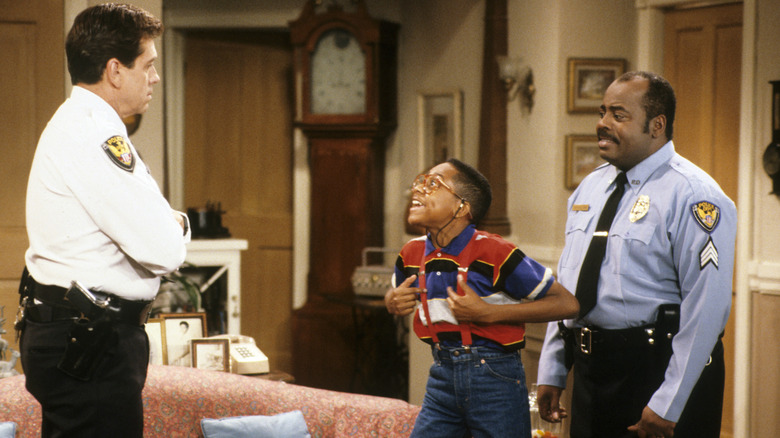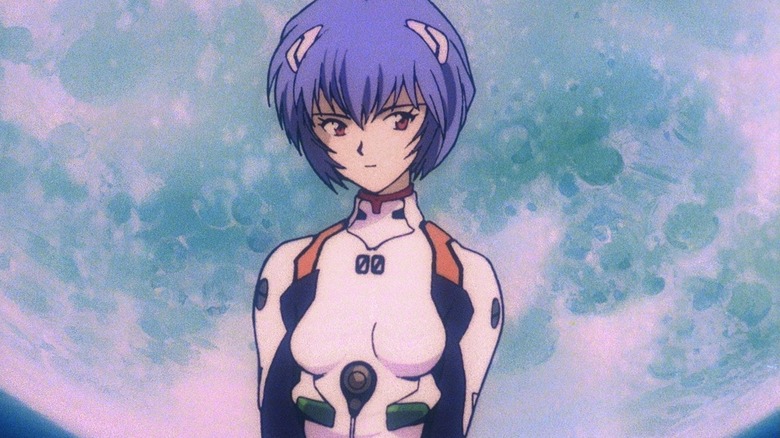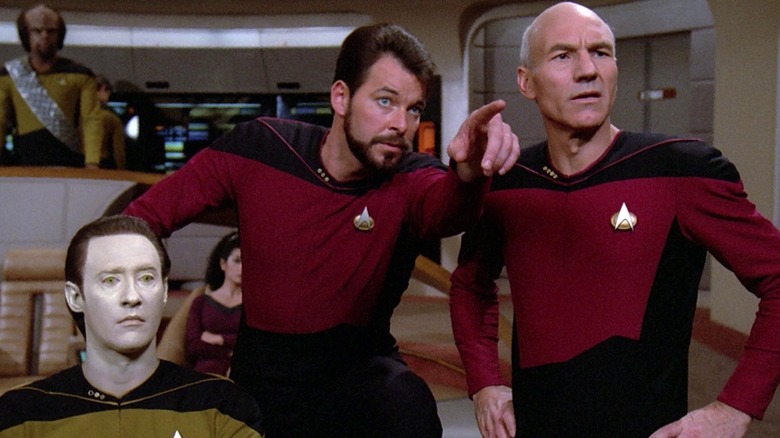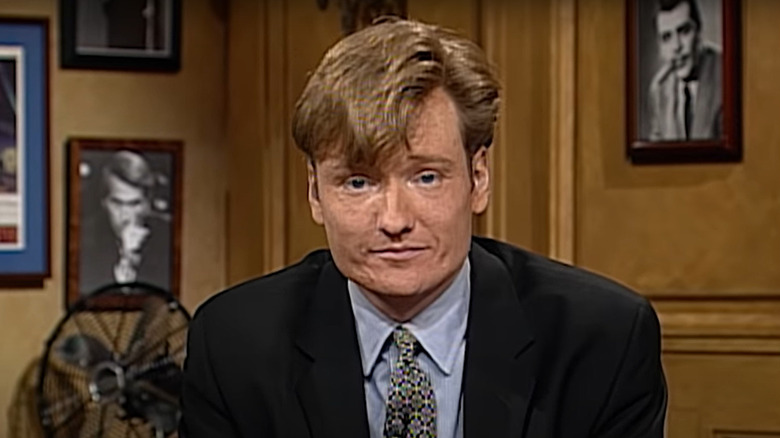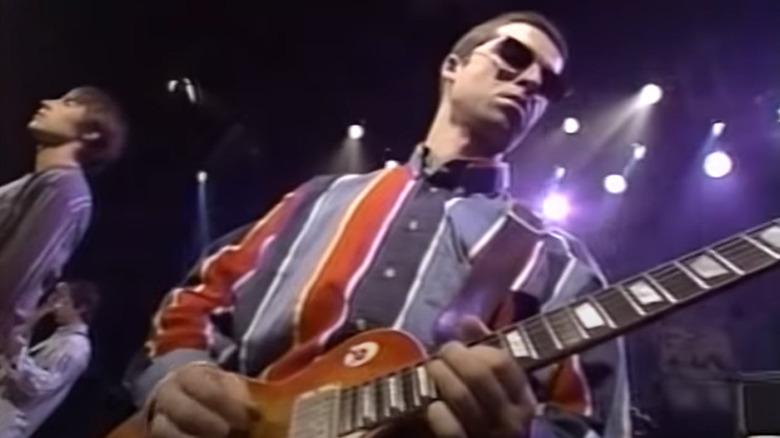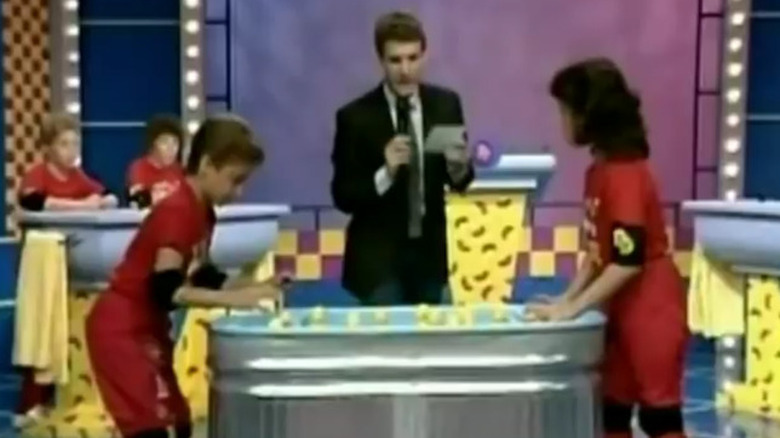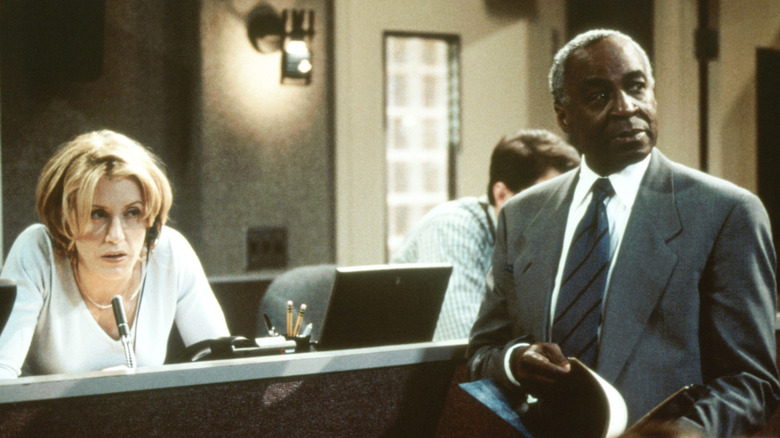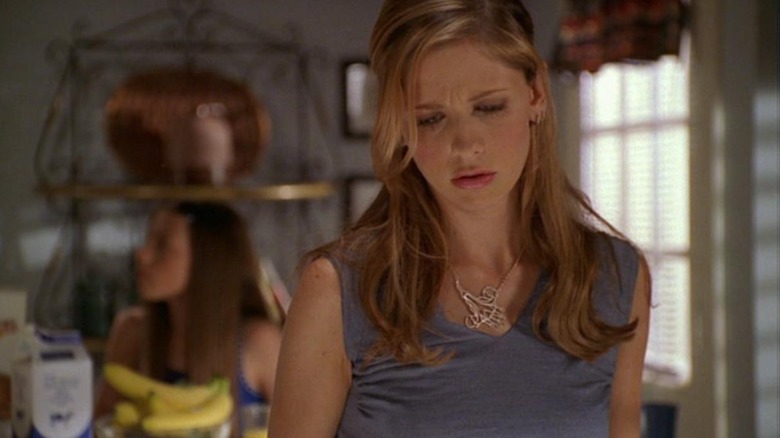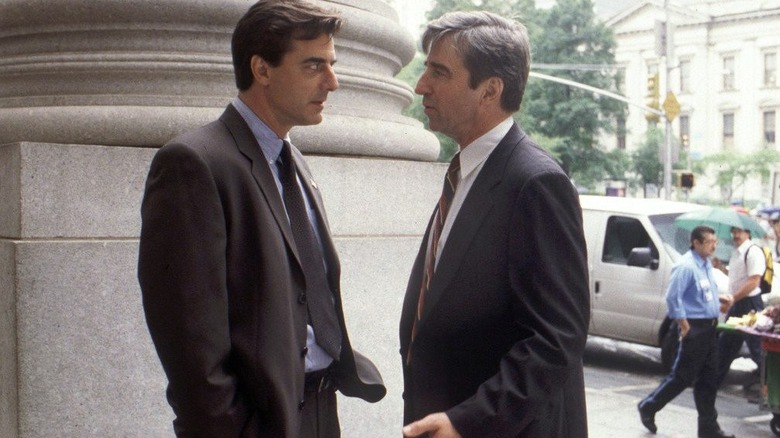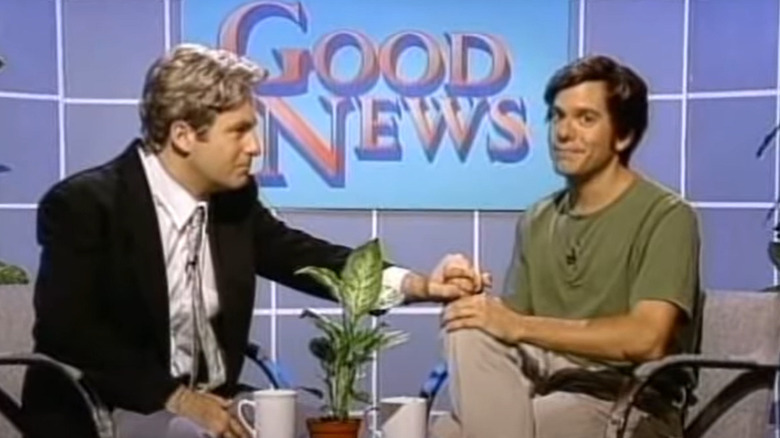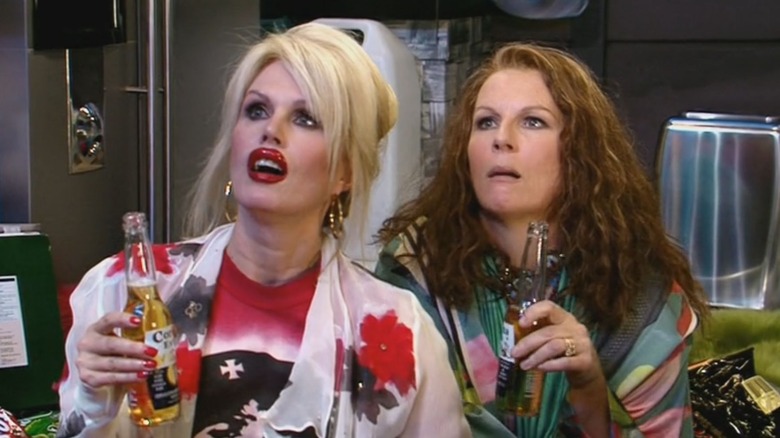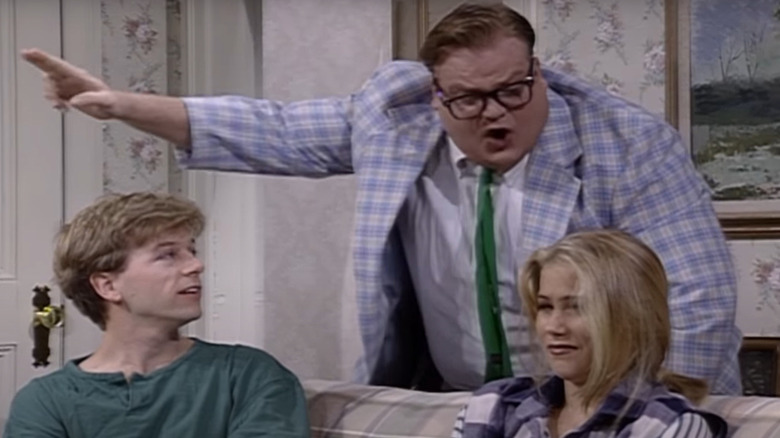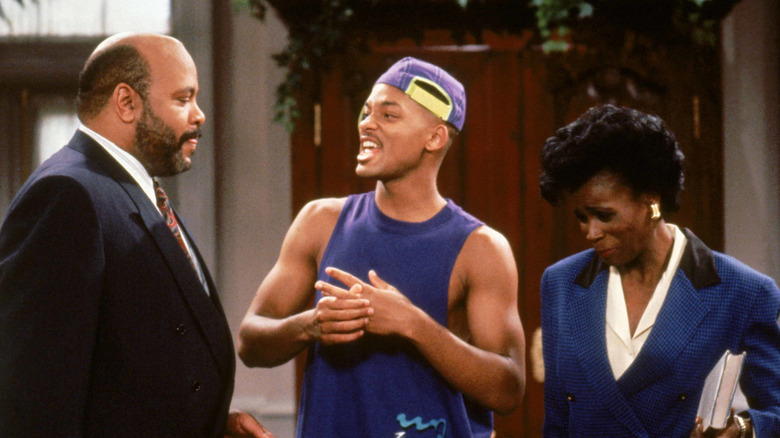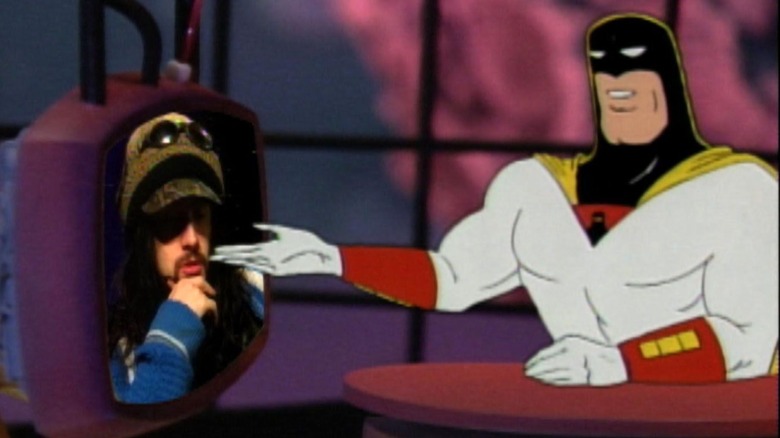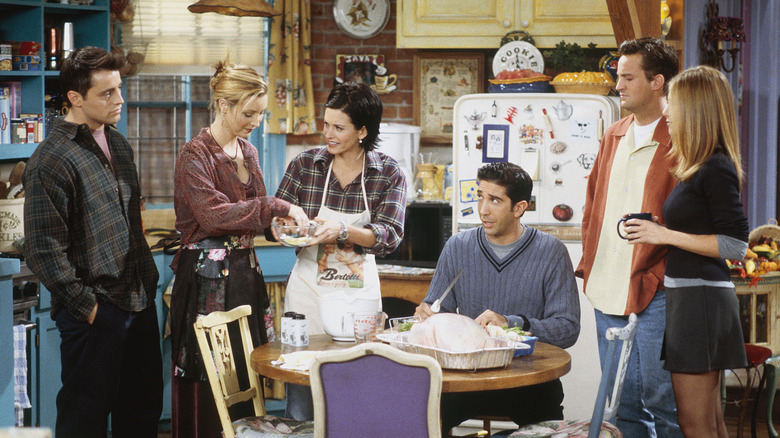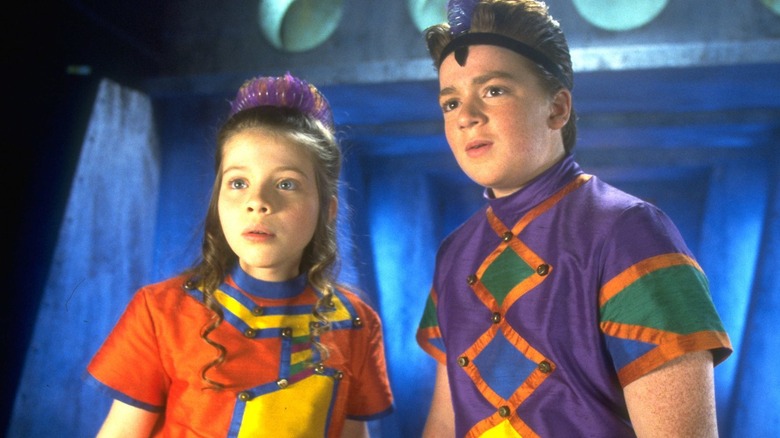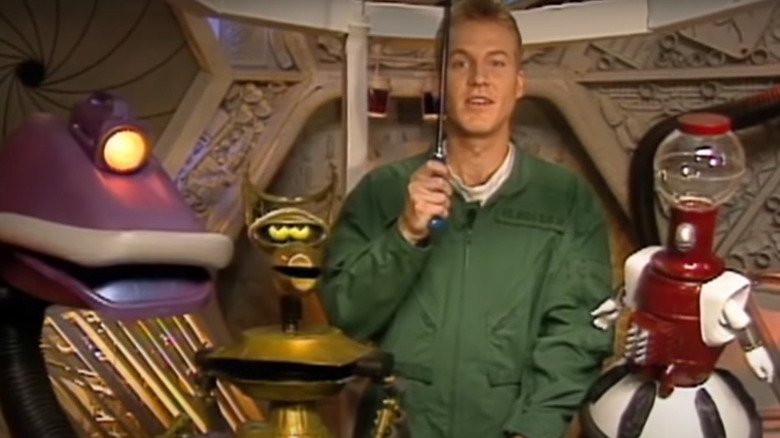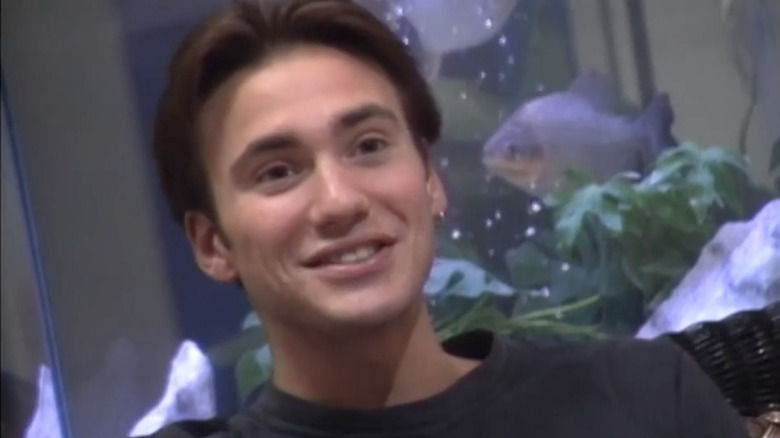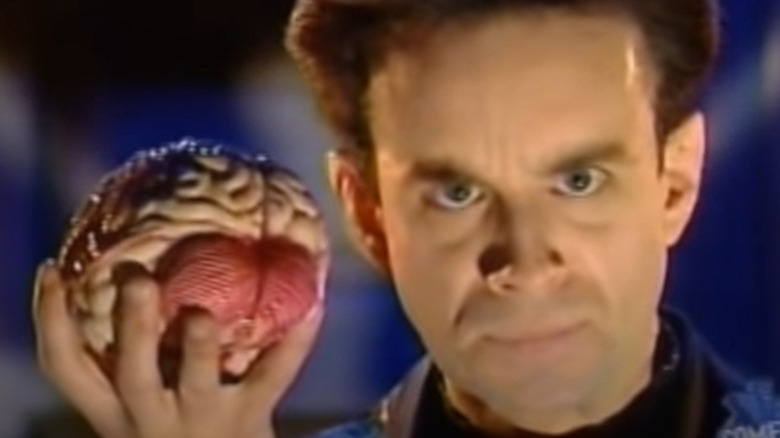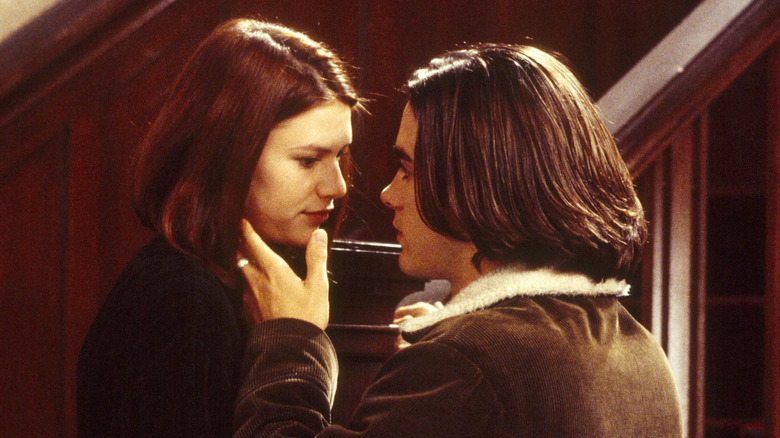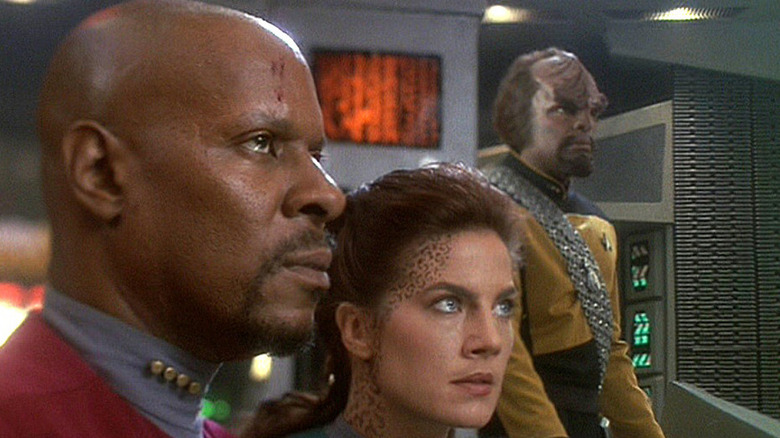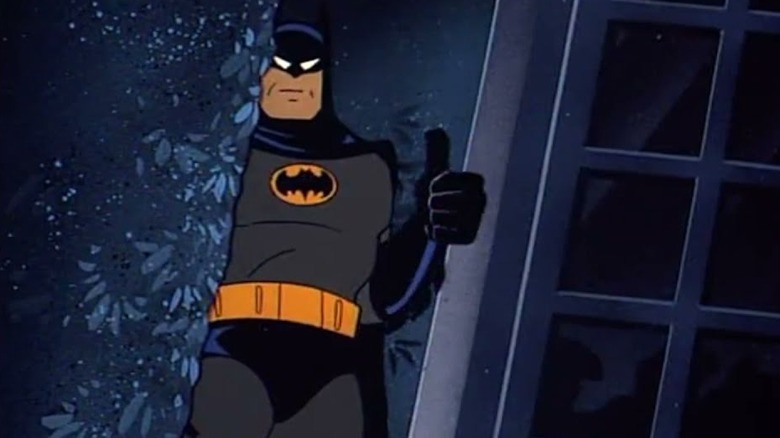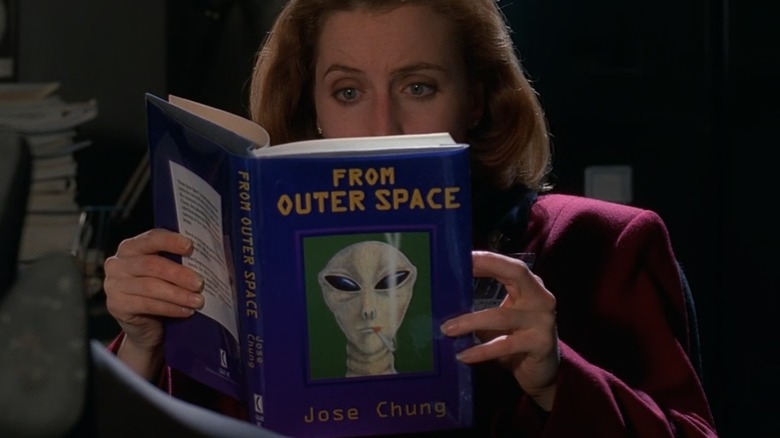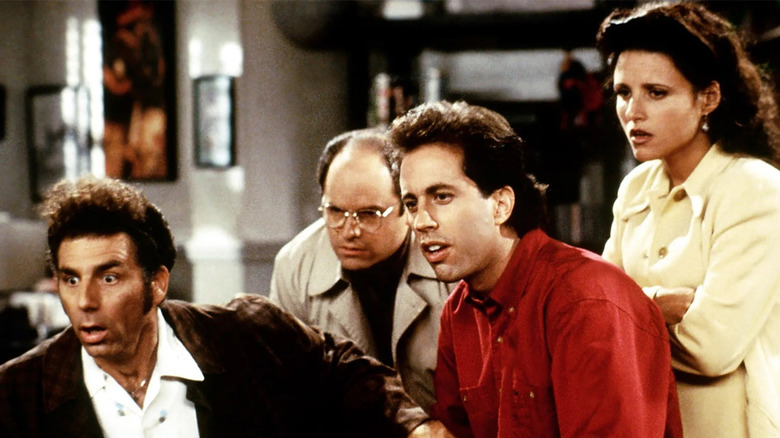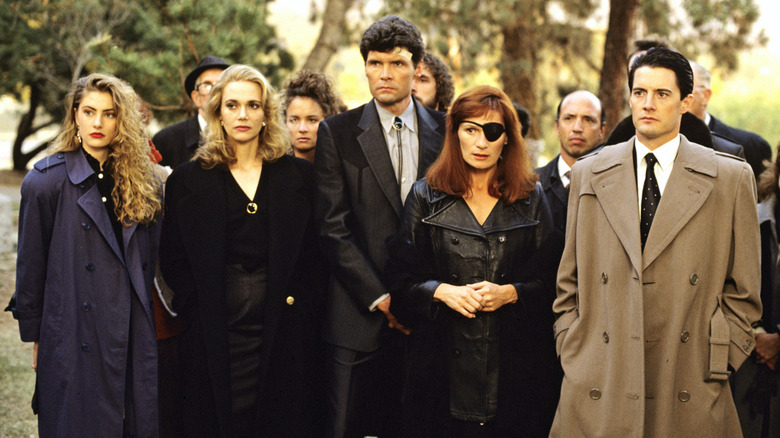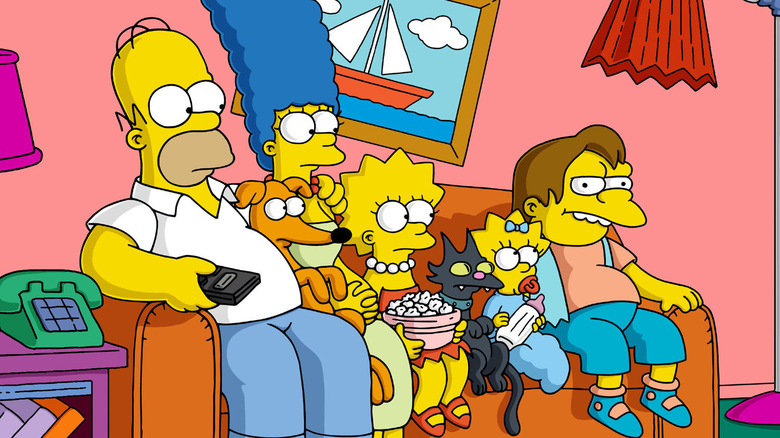95 Best '90s TV Shows Ranked
We watched a lot of TV in the '90s. Can you blame us?
In the '90s, the increased affordability of cable and the variety of channels included in a typical subscription package sent TV positively ballistic. Twenty-four-hour news channels emerged in conjunction with major celebrity scandals, including O.J. Simpson's murder trial, President Bill Clinton's infidelity with a White House intern, and Olympic figure skater Tonya Harding's alleged plot against rival Nancy Kerrigan.
The relatively new concept of channels catering to very specific demographics — MTV, Nickelodeon, ESPN, The Nashville Network, Cartoon Network, The Learning Channel, etc. — provided a virtual new frontier of creativity in programming and an unprecedented era of TV. In other words — while a solid percentage are utterly timeless — a lot of the best shows of the '90s could never be made today.
When given the choice of going big or going home, we went big, and compiled the following ranked list of the top 95 shows of the '90s, ranked according to their quality, ongoing relevance, and the indefinable but unmistakable quality of "90s-ness." As such, "The Sopranos" isn't listed, as it's essentially a 2000s show, much in the way "The Golden Girls" is basically a 1980s show.
If you happen to disagree with how we ranked your favorite — don't have a cow, man.
95. Dinosaurs
A brainchild of Jim Henson Productions airing on ABC between 1991 and 1994, "Dinosaurs" stuffs well-worn sitcom tropes into full-body puppets. It's fair to debate how well "Dinosaurs" holds up. At its worst, the show made sure Jessica Walter got paid for a few years before "Arrested Development" came along and provided us with the screeching comedy stylings of Baby Sinclair.
Upon encountering his father, Earl Sinclair, Baby would loudly observe that this was "Not the mamma" and assault Earl with whatever blunt object was available. Even when the rest of the show gets kind of boring, Baby Sinclair remains a hilarious standout. Too bad he definitely dies horribly at the end of the series.
94. The Head
Before Eric Fogel solidified his status on MTV by creating "Celebrity Deathmatch," he summoned up "The Head," which aired on the same network for two seasons between 1994 and 1996.
Roy is an extraterrestrial roughly as large as a medium-sized man who resides inside the head of Jim, a mild-mannered trade school student. Roy's living quarters demand a significant suspension of the audience's disbelief; if the show played by the same rules of physics that apply in reality, the weight of Jim's grotesquely enlarged skull would likely crush his neck.
As implausible as it may be, "The Head" is essentially about valuing others for their humanity instead of their appearance. There's a wholesome, heartfelt core of "The Head," visible to those who look past its routine displays of Cronenbergian body horror.
93. American Gladiators
A fixture of cable syndication throughout the Clinton administration, the original iteration of "American Gladiators" produced new episodes between 1989 and 1996. We can describe it as a precursor to "Ninja Warrior" with a few elements lifted from the WWF of the 1980s. Contestants with otherwise normal lives engage in athletic competition against a roster of "gladiators" — essentially bodybuilders with one-word nom de guerres like "Laser," "Tower," and "Blaze."
Despite occasional rumblings of a reboot, "American Gladiators" as a brand lacks an overwhelming truckload of cultural endurance. However, let's not forget that in the '90s, mixed martial arts was still considered too sadistic for social acceptability in large segments of the U.S. If a fellow or lady wanted to see something kind of like pro wrestling without predetermined outcomes, in many cases, "American Gladiators" was their best option.
92. Barney & Friends
Does anyone else remember when it was fashionable to just hate the ever-living daylights out of Barney? Why was that? What the heck was wrong with us?
In production semi-consistently from 1993 to 2009, "Barney & Friends" consists of the eponymous purple tyrannosaurus rex dancing and singing about fundamental concepts including self-esteem, happiness, love, and cleaning up after yourself. Naturally, the show is intensely mindless; it's designed for literal toddlers. The fact that the Chicago Tribune published an article titled "The Barney Backlash" in 1993 detailing the notable efforts of the anti-Barney agenda proves that mean-spirited jerks with too much time on their hands were invented well before the year 2000.
Fascinating side note — it just-so happens that "Barney and Friends" helped launch the careers of Selena Gomez and Demi Lovato during their early years as child actors.
91. Teenage Mutant Ninja Turtles
The original "Teenage Mutant Ninja Turtles" animated series launched in 1987, was wildly beloved by easily impressed small children, and concluded in 1996. Numerous superior iterations of the Ninja Turtles came to fruition during the ensuing years. As onetime superfans grew up, some of us couldn't help but notice that the original "TMNT" tries very hard to convince us to buy more action figures.
While we can look back with completely warranted cynicism about its shameless merchandizing, we cannot deny the seeming immortality of its iconography. Take a survey of TV viewers born between roughly 1982 and 1990 — we bet $100 half of them will remember the lyrics to the '87 "TMNT" theme song by heart, even if they haven't watched the show since it was new.
90. Baywatch
Considering the impact the "Baywatch" franchise has had on pop culture, it can be easy to forget that NBC canceled "Baywatch" after its first season in 1989, as the Los Angeles Times reported. However, the show thrived in syndication and continued production until the early 2000s. Perhaps this program has something going for it besides eye candy, after all?
Regardless, cable TV of the '90s would be entirely different without the beach-based action-drama co-starring and executive produced by David Hasselhoff. Without an opportunity to run at a camera in slow motion while wearing a swimsuit, Pamela Anderson might never have become famous enough for someone to steal her infamous tape. The proverbial butterfly effect of that hideous violation ceasing to occur would disrupt the timeline in ways that profoundly impact the life and career of Kim Kardashian, not to mention preventing "Pam & Tommy" from existing.
89. The Ben Stiller Show
In a vacuum, the single season of "The Ben Stiller Show" that appeared on Fox in 1992 plays out like "Mr. Show" outtakes with a curious lack of swear words. As far as a cursory internet scan tells us, "The Ben Stiller Show" is the first project Bob Odenkirk and David Cross worked on together, which makes it a very important program for the evolution of contemporary American comedy.
In addition, "The Ben Stiller Show" is a project featuring Ben Stiller and Janeane Garofalo that panned out as a financial disappointment, meaning it has a ton in common with "Reality Bites," possibly the most utterly '90s film of them all. Let us not forget to mention Odenkirk's timeless "Manson" sketch, which all these years later, still warms our hearts and reminds us to always be afraid.
88. Beverly Hills, 90210
While certainly the teen melodrama sensation of its era, "Beverly Hills, 90210" can't touch its modern-day equivalents. When it comes to virtually any metric of creative merit, "90210" isn't in the same league as "Euphoria," nor does it convey much of the smirking self-awareness fans enjoy so much on "Riverdale."
Even in the context of its own time, the Tori Spelling-starring soap delivers a glossy, opulent vision of teenage existence that scans like holdover from the 1980s. Nevertheless, we'd be remiss in our duty if we downplayed the influence of executive producer Aaron Spelling on television during the final few decades of the 20th century.
Spelling followed up 1980s smash hit "Dynasty" with "Beverly Hills, 90210," in which wealthy Californian teenagers cope with various social and personal dilemmas. The series premiered in 1990, ran until 2000, provided a basis for the spinoff "Melrose Place," and made celebrities out of Tori Spelling, Luke Perry, Shannen Doherty, and more.
87. Strangers With Candy
Jerri Blank is a 46-year-old high school freshman. She's not what anyone would call socially enlightened. She constantly makes lecherous advances toward her teenage classmates. In the series premiere, Jerri inadvertently kills a girl by selling her a powerful hallucinogenic drug.
Jerri Blank is a monster, but this is acceptable because Jerri Blank isn't real. It also doesn't hurt that we can't stay mad at the eternally charming Amy Sedaris, no matter how depraved and dangerous she pretends to be on TV.
"Strangers With Candy" is a gleefully dark teen melodrama satire that hung in there for three seasons on Comedy Central from 1999 to 2000. While its cult appeal failed to resonate with mainstream audiences, it was powerful enough to summon the mighty Winona Ryder to guest star as Flatpoint High School's most popular student in the finale episode.
86. Mighty Morphin Power Rangers
We suggest that whoever had the idea to splice American actors into "Super Sentai" episodes to create a whole new series about Californian teens who transform into sci-fi ninja superheroes deserves to have more money than Jeff Bezos. Anybody could've thought up selling books on the internet, but only a true genius could have conceived of "Mighty Morphin Power Rangers."
The Fox Kids vanguard and afterschool staple arrived in 1992, and technically continued until 1996 when what would've been the fourth season of "Mighty Morphin Power Rangers" was rebranded as "Power Rangers Zeo." Subsequent iterations of the Power Rangers never managed to capture our imaginations quite like the first wave. It appears to be the only era of the Power Rangers franchise to inspire an R-rated short film serving as a series epilogue for its fanbase of former kids who are currently thirtysomething weirdos.
85. Dawson's Creek
Since the majority of "Dawson's Creek" hit the airwaves in the 2000s, controversy surrounds our choice to include The WB's touchstone teen soap on this list of '90s shows. However, let's note that earlier in the decade, series creator Kevin Williamson joined forces with Wes Craven and unleashed "Scream" upon unsuspecting horror audiences. The association with indisputably one of the most emblematic films of the era surely gives "Dawson's Creek" a few extra '90s points.
Premiering in 1998, "Dawson's Creek" spins the yarn of weepy Cape Cod resident Dawson Leery, as he comes of age alongside childhood buddy turned high school sweetheart Joey Potter. Also along for the ride are his bro-ish longtime pal Pacey Witter and his additional love interest, juvenile delinquent Jen Lindley.
"Dawson's Creek" vaulted cast members Katie Holmes and Michelle Williams into bona fide stardom while demonstrating that there's more to Joshua Jackson than "The Mighty Ducks." Perhaps James Van Der Beek's post-"Dawson's Creek" career has been less prestigious but more interesting than his former costars. For instance, some of his work can be seen in the outstanding "Power Rangers" short film mentioned above.
84. The Tom Green Show
A lot of people really hated Tom Green in the '90s, which could not be helped. Overexposure tends to breed contempt for celebrity entertainers, and at least once a week throughout 1999, MTV made sure everyone in the country with a cable connection heard about Tom Green deliberately making some kind of terrible decision.
"The Tom Green Show" actually started on Canadian cable access in 1994, so contrary to how it might've looked to American audiences, the author and performer behind "The Bum Bum Song (Lonely Swedish)" was no overnight success. Sadly, new episodes of the original "Tom Green" only aired on MTV for a little more than a year and a half before an illness forced Green to step away.
During his late '90s/early '00s zenith of visibility and popularity, Green was known for subjecting himself — and often his family and close friends — to awkward, disgusting, humiliating public ordeals. You know how every sketch on Netflix's "I Think You Should Leave with Tim Robinson" is basically Robinson making all the other characters in the bit uncomfortable? "The Tom Green Show" does the same thing in real life, without actors.
A normal man performing the comedy of "The Tom Green Show" would've been beaten to death by an angry mob, but Tom Green is still alive because Tom Green is a god.
83. Animaniacs
"Tiny Toon Adventures" is a decent first try, but Steven Spielberg's Amblin Television didn't knock a cartoon project out of the park until "Animaniacs" arrived on Fox Kids in 1993. Whereas the Tiny Toons are half-sized versions of iconic Merrie Melodies characters, "Animaniacs" felt original and innovative to youngsters of the era. Granted, the Brain is clearly based on Orson Welles, and the Goodfeathers are a naked homage to the three primary gangsters of "Goodfellas." Luckily, the target demographic for "Animaniacs" was too young to be familiar with the works of Martin Scorsese or any other films for adults.
"Animaniacs" continued dispensing the madcap capers of siblings Yakko Warner, Wakko Warner, and Dot Warner, along with their associates until 1998. "Animaniacs" returned to television in 2020, so perhaps we'll write about it again on Looper's "200 Best Shows of the 2020s" list in 25 years.
82. Dr. Quinn, Medicine Woman
Jane Seymour stars in "Dr. Quinn, Medicine Woman," which aired on CBS from 1993 to 1998. While not a common favorite among the present-day generation of tastemakers, the story of an unaccompanied woman benevolently venturing into the American frontier – an environment often associated with the type of mayhem seen on HBO's "Deadwood" — probably belongs in the conversation about '90s-style TV feminism. Unlike Buffy and Xena, Dr. Quinn doesn't fight literal supernatural monsters. Instead, she pushes back against the metaphorical monster of misogyny.
Not that "Dr. Quinn, Medicine Woman" needs a stronger link to the '90s, but it just-so-happens that Orson Bean plays general store owner Loren Bray, and Bean also plays the confounding Dr. Lester in what is arguably the decade's greatest film, "Being John Malkovich."
81. Sailor Moon
The fact that pro wrestler and occasional "Mandalorian" star Sasha Banks can show up to a pay-per-view match in 2022 in "Sailor Moon"-inspired ring gear without anyone having to guess what her outfit is referencing speaks volumes to the strength of Sailor Moon's cultural legacy.
We're probably not going out on a limb by suggesting the average wrestling fan has never seen an episode of "Sailor Moon," but basically everybody recognizes that costume. That makes Sailor Moon about as deeply ingrained into the collective consciousness as just about any top-tier Marvel or DC character.
Based on a manga, the "Sailor Moon" anime kicked off in 1992 and chronicled the endeavors of a middle-school girl who receives superpowers from a talking cat. Sailor Moon battles evil and grows into adulthood throughout subsequent series originally broadcast through 1997.
80. Rocko's Modern Life
Nickelodeon's aptly dubbed "Nicktoons" lineup includes more lucrative ventures, but "Rocko's Modern Life" is the only one we remember watching on purpose at any point after President George W. Bush took office.
The four seasons of "Rocko" came about between 1993 and 1996. As the title strongly indicates, the program depicts a young adult wallaby and comic book store employee navigating the frequently perilous environs of his adopted home of O-Town. Unlike the dumb babies of "Rugrats," Rocko contends with adult problems like romantic inadequacy, financial distress, abusive giant frogs who are also homeowners and his neighbors, plus the insane dangers of laundry day.
As noted by Variety, a not-insignificant fraction of the folks who worked on "Rocko" went on score to jobs on "SpongeBob SquarePants." If they resented not making those fat "The Ren & Stimpy Show" bucks in the '90s, it would appear they have been compensated by destiny.
79. Legends of the Hidden Temple
The most memorable of Nickelodeon's several remixes of the "Double Dare" premise, "Legends of the Hidden Temple" is a trivia gameshow meshed with an Indiana Jones-themed LARP. "Legends of the Hidden Temple" aired new episodes from 1993 to 1995.
Host Kirk Fogg converses with Olmec — a face carved into a rock who wields ancient wisdom — and young contestants scramble to obtain artifacts loosely based on global history. There's a vaguely colonialist aura surrounding the otherwise brilliantly ludicrous endeavor, but there's a relaunched "Legends of the Hidden Temple" for adults in the pipeline, so the show can't be that problematic — right?
78. Doogie Howser, M.D.
ABC broadcast the four seasons of "Doogie Howser, M.D." from 1989 to 1994. Maybe "Doogie Howser, M.D." is your favorite show; more than probably, it is not. Neil Patrick Harris plays the title character — a child prodigy who speeds through medical school and becomes history's youngest licensed doctor at 14 years old.
Though its premise may be implausible, we owe "Doogie Howser, M.D." for introducing the world to N.P.H., without whom contemporary popular culture would be severely diminished. On a timeline where "Doogie Howser, M.D." never gets made, a lesser actor plays Thomas Anderson's therapist in "The Matrix: Resurrections" and "Dr. Horrible's Sing-Along Blog" probably stars Nicholas Brendon.
77. Blossom
NBC disseminated new episodes of "Blossom" from 1990 to 1995. Centered around the goings-on of mild-mannered yet immensely imaginative adolescent Blossom Russo, "Blossom" inspired enough backlash to mandate a mean-spirited "Saturday Night Live" parody. The haters must hate, it seems. As far as "Blossom" is concerned, its teenage protagonist's aesthetic sensibilities are so far ahead of the curb that fashion-minded young women were still lifting Blossom's style as recently as the late '00s. Today, Mayim Bialik and Joey Lawrence are still television stars. Stick that in your pipe and smoke it, "Saturday Night Live" in 1994.
76. Salute Your Shorts
"Salute Your Shorts" produced two seasons that aired on Nickelodeon between 1990 and 1992, and the summer camp-based kids' comedy has enjoyed remarkable cultural endurance despite its mere 26 episodes. Starring Danny Cooksey of "Terminator 2: Judgment Day" fame as Camp Anawanna's resident bully Bobby Budnick, "Salute Your Shorts" chronicles the off-kilter hijinks of Budnick, Donkeylips, Sponge, Camp Counselor Ug, and a handful of other characters who were not primarily referred to by degrading nicknames.
The legacy of "Salute Your Shorts" reaches as far as contemporary combat sports, as All Elite Wrestling star Chuck Taylor uses a maneuver called "The Awful Waffle" — named after a brutal yet enigmatic "Salute Your Shorts" prank — to knock out his opponents.
75. Homicide: Life on the Street
"Homicide: Life on the Street" prospered for seven seasons on NBC from 1993 to 1999, and its legacy has the misfortunate of being overshadowed by an even more acclaimed and groundbreaking Baltimore-based crime drama that premiered just a couple of years later. As far as remaining in the discourse for the long haul goes, "The Wire" kind of drained the air out of the "Homicide: Life on the Street" tires. Regardless, the latter program's influence on murder-solving oriented television would be substantial if its only contribution was introducing Richard Belzer and Giancarlo Esposito to the genre. Also, if you ever find yourself feeling like murdering someone, gaze upon this intensity and we bet you'll think again.
74. Gargoyles
A cynic might observe its ominous, Burton-esque urban landscape and gothic overtones, then correctly determine that "Gargoyles," really wishes it was "Batman: The Animated Series." A more optimistic and equally correct take on Disney's darkest cult favorite is it's a program about a group of heroic humanoid monsters who live in secret as outsiders in New York City, known only to their one human friend who happens to be a conventionally attractive young woman. In other words, this show also wants to be "Teenage Mutant Ninja Turtles."
The important difference is the "Gargoyles" gang routinely addresses moral and philosophical conundrums and contradictions that the slapstick Turtles of yore wouldn't touch for an extra-large New York-style pie with extra cheese.
"Gargoyles" aired from 1994 to 1997 and inspired enough enthusiasm to sustain 13 years of "Gathering of the Gargoyles" fan conventions. Nowadays, some folks wonder how much longer we'll have to wait for Season Four.
73. Viva Variety
One of Comedy Central's most underrated late '90s endeavors, "Viva Variety" transplants hosts Mr. and the former Mrs. Laupin — characters from Thomas Lennon and Kerri Kenney-Silver's previous program, "The State" — into their own fully realized variety half-hour. The show even featured authentic musical guests like They Might Be Giants, Reel Big Fish, Dionne Warwick, and Duran Duran. Michael Ian Black plays the divorced couple's announcer and boldly obsequious sidekick Johnny Blue Jeans.
While ruthlessly hilarious, perhaps the parody at the core of "Viva Variety" didn't quite land because basically nobody in America has ever seen a European variety show. Meanwhile, we've all seen a million reality cop shows, which is why Lennon and Kenney's follow-up effort, "Reno 911," panned out into something a little more sustainable.
72. Dragon Ball Z
Originally broadcast in Japan from 1989 to 1996, the second series in the "Dragon Ball" franchise became, alongside "Gundam Wing," the cornerstone of Adult Swim's Toonami block of programming. Goku and his fellow Z-Fighters train like crazy and wage noble campaigns against global threats, including Frieza, Cell, and Majin Buu. "Dragon Ball Z" was the beginning of millions of previously socially ambitious American youths transformation into anime nerds, which means this nation owes the Toei Animation production studio a huge debt of gratitude.
"Dragon Ball Z" is particularly noted for the magnitude and grandiosity of its fight sequences, and their relative awesomeness remains a topic of deadly serious debate to this very day.
71. Lois & Clark: The New Adventures of Superman
Pretty much every decade has its own live-action version of Superman and Lois Lane, and the '90s got Dean Cain and Teri Hatcher. The four seasons of "Lois & Clark: The New Adventures of Superman" that aired on ABC from 1993 to 1997 have been described as "The Most '90s Show Ever" by Syfy. While we don't totally vouch for that idea, we can immediately see where it has some merit — especially with regards to Superman and his colleagues.
"Lois & Clark" plots involving the repeated death and resurrection of Lex Luthor are pretty freakin' ironic, considering "The Death of Superman" is a serious contender for the "The Most '90s Comic Ever." At one point, Hatcher's version of Lois Lane contends with an evil clone of herself, much as Peter Parker must do in yet another thoroughly '90s comic, "The Clone Saga." It was a pretty weird decade for A-lister superheroes, but at least Superman and Spider-Man never had to deal with Joel Schumacher.
70. Babylon 5
Starting with a straight-to-TV movie in 1993, "Babylon 5" carried on officially as a series from 1994 to 1998. Creator, showrunner, and future controversial "Spider-Man" writer J. Michael Straczynski mapped out his entire vision for what became the five-season story before he sold a studio or network on the concept. This was a highly unique approach, especially considering that long-term serialized TV drama was not as common as it is today.
As it features a diverse set of outer space denizens cohabitating a space station, there's some speculation that Paramount copied and pasted the basic concept of "Babylon 5" to make "Star Trek: Deep Space Nine." This would have been impossible, of course, as all television executives live by an ironclad code of honor against unoriginality.
69. Spaced
One of the two seasons of "Spaced" aired in 1999, the other in 2001. While the UK slacker sitcom barely qualifies as a '90s show strictly in terms of timing, its late Gen X and early millennial bona fides are not to be trifled with. It's a show about aimless, recently single twentysomethings who dwell in slummy apartments and obsess over comic books. A successful attempt at transferring "Clerks" or "Mallrats" to the half-hour television format would probably look and sound a lot like "Spaced." It's also the program that initially informed us of Edgar Wright, Simon Pegg, and their various associates, so perhaps we'll include it on our "200 best shows from the 2000s" list — if we ever go insane enough to compose such a thing.
68. The Magic School Bus
Based on a children's book series of the same name, "The Magic School Bus" transformed and traveled into bizarre situations for educational purposes on PBS between 1994 and 1997. Ms. Frizzle's field trips through space and time taught more than a few of us how human organs function, the number of other planets in the solar system, the environmental necessities of bees, ants, bacteria, and other disturbing and small forms of life. Best of all, the show conditioned us to become enthusiastic "Doctor Who" viewers in time for the 2005 relaunch.
67. Ellen
Today Ellen DeGeneres is America's most performatively friendly daytime television personality. In the '90s, she was one of the most controversial performers in mainstream entertainment.
Eagle-eyed viewers might've already noticed this list of '90s shows lacks much in the way of LGBT representation. That's because — sorry to harsh the nostalgia buzz — the '90s was a severely homophobic period in American pop culture. DeGeneres's 1997 coming out in real life and in character on "Ellen" — her ABC sitcom lasting from 1994 to 1998 — seemed like a big deal at the time. While the 2000s brought about shows like "Six Feet Under," "The L Word," and "Will & Grace," as far as scripted American television in the '90s goes, DeGeneres was pretty much out there by herself.
66. The State
Hazy late-night memories of "The State" formed during its tenure on MTV from 1993 to 1995 gave some of us the impression that MTV executives really wanted their own "Kids In The Hall." Maybe that's true, maybe it isn't, but in the overall scheme of things, it doesn't matter at all.
"The State" alumni have their fingerprints all over the subsequent 30 years of American comedy, with one or multiple "The State" cast members owning varying degrees of credit for "Reno 911!," "Wet Hot American Summer," "Viva Variety," "Search Party," "Party Down," "Stella," "The Big Sick," "The Other Two," "Childrens Hospital," and enough others to keep this list going on for quite a while longer.
According to television mythology, "The State" would've stayed on the air longer if its stars hadn't made an ill-advised bid to move to CBS, but things worked out for the best. The cast members of "The State" clearly had better things to do than be "The State."
65. Ally McBeal
The most well-known of prolific executive producer David E. Kelley's numerous programs, "Ally McBeal" stars Calista Flockhart as the title character, a Beantown lawyer with a more active-than-average romantic inclination. The series ran on Fox from 1997 to 2002.
"Ally McBeal" was enough of a sensation to inspire parodies from other major programs of the day. In the 1999 "Futurama" episode "When Aliens Attack," a conquest-minded race of extraterrestrials invade Earth because they aren't able to watch the season finale of "Single Female Lawyer." In the classic "Millennium" episode, "Somehow, Satan Got Behind Me," a dancing baby demon — in the mold of a dancing baby sometimes hallucinated by Flockhart's character – menaces a television executive until he loses his mind entirely.
64. WCW Monday Nitro
Hulk Hogan became a crossover megastar in the 1980s as the headlining act of the World Wrestling Federation (WWF, currently known as WWE), and left for the competing World Championship Wrestling (WCW) in 1994. After a few years of continuing to inhabit his familiar, passé superhero-style persona, Hulk Hogan betrayed the good guy wrestlers to lead the infamous faction known as the N.W.O. A star on Hogan's level turning heel came off as an unprecedented, shocking storyline swerve and left an impression that anything was possible in WCW.
A brutal and historic ratings war between WCW Monday Nitro and WWF's Monday Night Raw ensued. WCW eventually buckled under a series of poor creative and business decisions, and Monday Nitro ended its six years on TNT in 2001.
While the main events tended to revolve around the N.W.O., Sting, and Bill Goldberg, nowadays Nitro is notable for an undercard that introduced national audiences to Eddie Guerrero, Chris Jericho, and many other all-time great luminaries of the squared circle.
63. Batman Beyond
Having logged "Batman: The Animated Series" and "Superman: The Animated Series," the DC Animated Universe took its next step into a dystopian future vision of Gotham City with "Batman Beyond." With the entirely original character Terry McGinnis at its center, "Batman Beyond" ran for three seasons airing on Kids WB from 1999 to 2001. "Batman Beyond" only broadcast about half of its 52 episodes before the year 2000, but as is the case for "The Matrix," this show owes a major debt to cyberpunk aesthetics and the rave scene of the '90s.
In 2039, an elderly Bruce Wayne coaches a young Terry as he takes over the Batman persona. Kevin Conroy returns to voice Bruce Wayne, as he'd continue to do in the following DCAU series, "Justice League."
62. ER
Technically, "ER" aired more new episodes in the 2000s than it did in the '90s, as the quintessential hospital drama persisted on NBC from 1994 to 2006. However, George Clooney left the cast after 1999's fifth season. The fact that "ER" carried on for seven more years without its breakout star speaks to the elasticity of the soap opera format and the passion of the "ER" fanbase. Nevertheless, the foundational phase of "ER" is definitely an entity of the '90s.
"ER" chronicles the struggles of the overworked staff at a Chicago hospital and was the longest-running primetime medical drama in network TV history until "Grey's Anatomy" surpassed its longevity in 2019, per The Hollywood Reporter.
61. X-Men: The Animated Series
Considering the ongoing renaissance of superheroes in live-action media, there's probably no way to understate the influence of "X-Men: The Animated Series" on the millennial generation. The instantly popular serialized saga — primarily based on Chris Claremont-penned comics of the late 1970s and 1980s – presented colorful heroes with distinct personalities and a tendency to clash. For fans of animated Marvel and DC who once considered "Super Friends" the height of the genre's sophistication, "X-Men: The Animated Series" was mind-blowing.
In case you haven't heard, as far as "X-Men: The Animated Series" is concerned, there's more where that came from.
60. Living Single
There's no getting around it. Right there in the theme song, it says, "In a '90s kind of world, I'm glad I've got my girls." The five seasons of "Living Single" that aired on Fox from 1993 to 1998 must be included in this list of top '90s TV shows if it is to have any integrity at all.
In "Living Single," four young professional women cohabitate an apartment in Brooklyn. Combined with their pair of frequent male associates, "Living Single" comprises a group of, ahem, friends whose series premiered a year ahead of any venture starring Jennifer Aniston and David Schwimmer.
"Living Single" is not the black "Friends." "Friends" is the white "Living Single."
59. Superman: The Animated Series
Just about the only thing DC Animation could do to follow "Batman: The Animated Series," "Superman: The Animated Series" fought the good fight on Kids WB from 1996 to 2000. The series features Tim Daly, Dana Delany, and Clancy Brown all cranking out definitive voice performances for their respective characters. Beyond that, "Superman: The Animated Series" accomplishes the paradoxical dual tasks of bringing the Man of Steel back to his roots and moving him forward into the modern era.
With ABC's "Lois & Clark: The New Adventure of Superman" telling audiences Superman is a workplace sitcom hunk, and DC Comics' "The Death of Superman" offering a grim vision of Superman pummeled to oblivion by Doomsday, the '90s lacked a consistent iteration of Superman.
Luckily, the timeline originally established in "Batman: The Animated Series" is grounded enough for Clark Kent to be a wholesome regular guy with a marginally glamorous journalist career, who is also murdered by extraterrestrial demons and resurrected at one point in his life. "Superman: The Animated Series" provided Superman with a stable TV baseline right up until 2001, when "Smallville" came along and turned him into a hormonal teenager.
58. Boy Meets World
"Boy Meets World" appeared on ABC from 1993 to 2000. Throughout seven seasons, we watched well-meaning but unruly middle-schooler Cory Matthews — played by Ben Savage, younger brother of "The Wonder Years" star Fred Savage — evolve into an awkward college guy. Savage is a fine actor, but heartthrobs Rider Strong and Danielle Fishel – who played Cory's best pal Shawn Hunter and Cory's girlfriend Topanga Lawrence — probably had about as much to do with the show's popularity, if not a little more. William Daniels plays Mr. Feeny, who is implausibly always teaching at whichever academic institution Cory and his circle happen to be attending at the time.
57. King of the Hill
Mike Judge's second animated series of the '90s ran on Fox from 1997 to 2010. Ironically, "King of the Hill" would probably be ranked higher on this list if it had been less successful and canceled in 1999.
Though its '90s cred is questionable, "King of the Hill" established Judge as a talent with abilities beyond "Beavis and Butt-Head." The series creator also voices Hank Hill — who prides himself on being a simple, traditional salesman of propane and propane accessories. Along with his wife Peggy, Hank raises his slightly overweight but gregarious son Bobby in the sleepy town of Arlen, Texas.
56. Roseanne
"Roseanne" ran for 10 seasons on ABC from 1988 to 1997 and was a profound ratings success. The legacy of the eponymous star has become embroiled in embarrassing controversy. Luckily, we can discuss the career of her costar John Goodman instead.
Easily one of the '90s most significant and influential actors, the scope of Goodman's career extends well beyond his tenure as Dan Connor on "Roseanne." Goodman plays essential roles in "Barton Fink," "The Big Lebowski," and "The Flintstones" — that's two of the decade's most lauded pictures and one that's an example of a bizarre '90s Hollywood fad of making very average films based on TV shows from the '60s and '70s.
55. Spawn: The Animated Series
Overall, the '90s was an exceptionally productive decade for superheroes in animation. Between the X-Men, Batman, Superman, and Spider-Man, almost every A-lister from DC and Marvel publishers wound up at the center of a high-quality, well-received cartoon. Despite their overtures towards emotional complexity, those shows are all for kiddies. They might be relatively mature, but they can never be "mature content." "Todd McFarlane's Spawn" — new episodes of which appeared on HBO from 1997 to 1999 — is the superhero show with cuss words, intimacy, and blood.
Gloomy visuals, thoughtful writing, and deliberate pacing all maneuver "Spawn" away from a destiny of edgelord wish fulfillment. Envision 18 pretty good R-rated episodes of "Batman: The Animated Series" — that's roughly what "Spawn: The Animated Series" brings to the table.
54. All That
According to his IMDb, Kenan Thompson started his television career with Nickelodeon's sketch comedy series "All That" in 1994. Following his departure from "All That" in 2000, he joined the cast of Saturday Night Live — where he has remained ever since — in 2003. As a result, Thompson has been a major part of sketch-based comedy television for the better part of three decades.
Be that as it may, Thompson's costar Kel Mitchell's performance of Ed the Good Burger cashier feels more emblematic of the '90s. Perhaps that's partially because of Mitchell's comparatively limited time in the spotlight following "All That" ties him closer to the decade. It's also because Ed is a family-friendly version of the same basic concept as Jay or Silent Bob — an obvious stoner who strategically never mentions why he's always in such a good mood.
53. Party of Five
Following a fatal car accident, the Salinger tribe can no longer rely on their parents' emotional or financial support. The five siblings must manage the family restaurant themselves while dealing with the type of upheaval often associated with teenage and twentysomething life — dating, booze, etc.
"Party of Five" — which ran for six seasons on Fox, 1994 to 2000 — was no instant smash, but after a few years, pretty much the entire main cast became household names. The primetime drama launched Neve Campbell and Jennifer Love Hewitt into essentially temporary but memorable phases of movie stardom, while Matthew Fox starred in a contender for our 200 best shows of the 2000s list, "Lost."
52. Freaks and Geeks
In most television shows about teenagers, the characters don't talk or behave like actual teens. Instead, they speak and act like idealized caricatures conjured up by professional television writers because actual teens are frequently unpleasant to be around, let alone watch. "Freaks and Geeks" — which successfully aired a mere 12 episodes before its cancellation and solidification as an underappreciated cult classic forevermore — depicts characters that are excruciatingly uncomfortable to watch because they succeed in portraying teenage awkwardness a little too well.
The show's single season, which was helmed by future Hollywood big shots Judd Apatow and Paul Feig while featuring future stars like Seth Rogen and James Franco, only aired five episodes before 1999 turned into 2000. Then again, even though the '90s was a decade that valued authenticity, "Freaks & Geeks" was a little too authentic to stay on the air. Or was it?
51. The Maxx
Even during its brief mid-'90s phase of broadcasting experimental animation, MTV's adaptation of Sam Kieth's psychedelic superhero deconstruction is too weird to make it to a second season. Violent, morose, and self-consciously absurd, "The Maxx" plays in the same sandbox as "Spawn" and other emblematic '90s superhero endeavors. However, this specific reality-agnostic action cartoon feels relevant to modern times in ways Todd McFarlane's dream of the '90s does not.
The Maxx's arch-enemy – dimension-hopping ostensible wizard Mr. Gone — is essentially what we'd now call an incel terrorist whose methods for coping with trauma provide the thematic thread tying a heap of abstractions and dream logic together. Likewise, the blend of computer graphics and images lifted directly off of Kieth's panels evokes as much bleakness and lunacy as it ever did.
Whereas "Watchmen" and "The Boys" swing their superhero critiques at the big picture, "The Maxx" explores the Jungian implications of our fixations with larger-than-life superheroes. How is it possible that Channing Tatum is the only person in Hollywood who wants to make a live-action adaptation of this?
50. WWF Monday Night Raw
Taking a cue from the Philadelphia-based indie sensation Extreme Championship Wrestling, the company then known as the World Wrestling Federation ditched the kid-friendly approach associated with its late '80s heyday and leaped into grittier PG-13 territory. The resulting so-called Attitude Era marks a boom period in creativity and popularity the company presently known as the WWE has not experienced since.
Where exactly the Attitude Era begins is a matter for some debate. However, two potential starting points are the debut of Dustin Rhodes' controversial Goldust character in 1995 or Stone Cold Steve Austin's infamous proclamation to the provisionally religious Jake "The Snake" Roberts that "Austin 3:16 just whipped your ***" at the 1996 King of the Ring. Between then at the Attitude Era's early '00s twilight, America got to know a brash young athlete nicknamed The Rock, who famously held the tag team titles as half of the Rock 'n' Sock Connection alongside Mankind.
49. Northern Exposure
"Northern Exposure" is inexplicably difficult to find on any streaming service, setting it apart from the bulk of critically-acclaimed, Emmy-winning rating sensations of the early '90s.
The high cost of medical school and a series of unforeseen circumstances forces New Yorker Dr. Joel Fleischman to move to the literal middle-of-nowhere burg of Cicely, Alaska. From what we can tell, Cicely is sort of like Stars Hollow from "Gilmore Girls," except without a tourism economy and featuring the extreme cold and isolation that enhances the weirdness and questionable sanity of the population.
The comedy-drama — prospering for six seasons on CBS from 1990 to 1995 — is noted for its application of magical realism, which apparently included predicting events that would occur 25 years after its cancellation.
48. Full House
So maybe it's not a "good" show by traditional metrics of quality, but "Full House" — with eight seasons running from 1987 to 1995 on ABC, followed by several years in syndicated reruns — was inescapable throughout the '90s.
Widower and morning talk show host Danny Tanner — portrayed by foul-mouthed standup Bob Saget, secretly playing against type — raises his three daughters with the help of his failed comedian buddy Joey Gladstone. Also in the mix is his failed musician brother-in-law, "Uncle" Jesse Katsopolis. Saget, Dave Coulier, and John Stamos all got relatively famous, but they were still nobodies compared to breakout stars Mary-Kate and Ashley Olsen, who played the youngest of the three Tanner sisters, Michelle.
If you decide to rewatch "Full House," remember, Bob Saget isn't getting upstaged by babies who eventually grow up and realize they don't like acting. Bob Saget is making it look like the babies are funnier and smarter than he is, because he was talented enough to do stuff like that.
47. The Wonder Years
By premiering in 1988 and closing with an exemplary finale after six seasons in 1993, "The Wonder Years" just about splits the difference between the late '80s and early '90s. Nevertheless, both in terms of its original broadcasting schedule and its themes, "The Wonder Years" is very much a '90s show.
Told from the perspective of an adult Kevin Arnold gazing back at his youth in ordinary American suburbia, "The Wonder Years" embodies the nostalgia for the late '60s and 1970s also on display in films like 1993's "Dazed and Confused," and 1996's "That Thing You Do!" By emphasizing a perceived fundamental wholesomeness of middle-class American life, "The Wonder Years" also rejects the skepticism of '80s films with similar settings such as 1984's "A Nightmare on Elm Street," 1986's "Blue Velvet," and maybe even 1985's "Back to the Future."
The '90s weren't perfect, but at least the decade overall wasn't as cynical as the '80s.
46. Æon Flux
"Æon Flux" certainly isn't the first animated action program targeted at a grown-up audience, but if you were born in the '80s, it's probably the first one you remember. With new episodes airing sporadically on MTV from 1991 to 1995, the cerebral sci-fi show stands as easily the most influential section of MTV's "Liquid Television" lineup. Even three decades down the line, the evidently superhuman gymnastic abilities of the show's eponymous protagonist, extra-lanky designs of the human form, and unconventional sexual overtones all make "Æon Flux" entirely distinct from the pack of animated shoot 'n' slash 'em-ups.
Not unlike "Cowboy Bebop," the visual presentation baked into its animation style makes "Æon Flux" a questionable candidate for a live-action adaptation, but Hollywood tried anyway. Whether or not anyone learned anything from the debacle of 2005's "Æon Flux" remains to be seen.
45. Married... with Children
Before "The Simpsons" came along in 1989, the fledgling Fox Network needed a hit to give it a clear sense of relevance and identity. Without "Married... With Children," which smashed out 11 seasons between 1987 and 1997, today's entire entertainment and media landscape might look completely different.
During its '90s heyday, liberals hated the raunchy sitcom because of its misogynistic and homophobic humor. Conservatives hated it because the female characters frequently spoke disrespectfully towards the male characters, and the show made no effort to hide or deny the existence of gay people. All this amounted to a situation where the mere act of watching the Bundy family's shenanigans meant you were rebelling against somebody. This essentially hollow sense of anti-authoritarianism would not have kept the show in production for 10 years on its own, however. For that, it needed a cast of television titans, including Christina Applegate, Katey Sagal, and Ed O'Neill.
44. Xena: Warrior Princess
These days, plenty of genre television programs feature female protagonists. In the '90s, such a thing wasn't entirely unheard of, but it was enough of a rarity for "Xena: Warrior Princess" to instantly scan as a bold departure from "Hercules: The Legendary Journeys" — the far less imaginative and innovative series from which it spun off of.
Lucy Lawless plays redemption-seeking ex-baddie Xena, who wanders the Earth seeking wrongs to right. Always at her side is trainee warrior Gabrielle, portrayed by Renee O'Connor. The pair's intense but platonic relationship marks an early instance of the phenomena currently referred to as "shipping," which often results in fanfiction that places two characters in a romantic relationship. However, contemporary "ships" generally aren't heavily implied in the subtext of their source material.
43. The Sifl and Olly Show
History may never bestow Matt Crocco and Liam Lynch's "Sifl and Olly" with its proper respect, and that's a gosh darn crime.
The eponymous sock puppet hosts sing catchy original tunes, wax philosophical, scream with fury, curse like sailors, and shill obviously dangerous products on behalf of the diabolical Precious Roy's Home Shopping Network. Each half-hour is a glorious, perception realigning viewing experience.
Sadly, "Sifl and Olly" came and went between 1998 and 1999. MTV didn't seem to bother marketing the show to the same audience for scatter-brained stoner-friendly humor that made "Space Ghost Coast to Coast" and "Aqua Teen Hunger Force" million-dollar franchises. Still, it was nice to have a really good reason to stay up until 1 a.m. on a school night for a little while.
42. Millennium
The "X-Files" spinoff that's even more disturbing than "The X-Files," "Millennium" maintained for three seasons on Fox from 1996 to 1999. Lance Henriksen plays FBI consultant Frank Black, cursed with a psychic ability to see into the minds of the evildoers. Black works with the enigmatic Millennium Group alongside Peter Watts, portrayed by future "Lost" star Terry O'Quinn — but is the Millennium Group what it seems?
No. The Millennium Group is not what it seems.
The first season consists of Frank hunting the serial killers of the week. It's quite well and good, but it might as well have been titled "Se7en: The Series." In Season 2, "Millennium" lives up to its title and explores anxieties and prophecies surrounding the looming year 2000.
We suppose the show lost a lot of pertinence once the year 2000 came and the world didn't end, but we'd still rank the best "Millennium" episodes right up there next to the most triumphant hours of Mulder and Scully. As Peter Watts himself might say, this is who we are.
41. Dr. Katz, Professional Therapist
Both a showcase for standup comics and a therapy-based sitcom, "Dr. Katz" delivered new episodes on Comedy Central from 1995 to 2002. Jonathan Katz provides the voice for the man in the chair. H. Jon Benjamin — the present-day Bob Belcher and Sterling Archer — portrays Ben, Dr. Katz's listless adult son. "Dr. Katz" also served as a trial run for the Squigglevision style that animator Tom Snyder would later perfect on "Home Movies."
Nowadays, animated comedy tends to rapid fire blast gags against the wall in hopes of something sticking. "Dr. Katz" keeps its deliveries subdued and casual. There's an almost soothing aspect to the show, that somehow withstands the not infrequent shouting emanating from Ben and Dr. Katz's many famous patients, including Ray Romano, Dave Attell, and Wanda Sykes.
40. The Nanny
Probably the decade's second-most beloved fish-out-of-water sitcom, "The Nanny" enjoyed a prosperous six season run on NBC that lasted from 1993 to 1999. Fran Drescher stars as Fran Fine, a stylish denizen of working-class Queens, New York, who stumbles into a job as the live-in caretaker to the three children of wealthy, stuck-up theater producer Maxwell Sheffield. While Fran hashes out the dos and don'ts of her new moneyed stomping grounds, butler Edward Niles constantly hurls merciless insults at Max's business partner, C.C. Babcock.
While popular in its day, "The Nanny" wasn't appropriately recognized as its generation's answer to "I Love Lucy" until it landed in the cultural rearview mirror. The enlightened critics of modern times don't question the relative merits of "The Nanny" — rather, they fight over which parts are the funniest.
39. The Critic
Topical humor starts becoming dated pretty much immediately after the respective joke hits the airwaves. Maybe that doesn't always have to be a bad thing?
For instance, "The Critic" is the only show we can think of with a significant fraction of its gags based on movies that came out sometime in the mid-'90s. Are you longing to hear someone knock Sylvester Stallone's "Cliffhanger" or Arnold Schwarzenegger's "True Lies" down a notch or two? Then you're pretty much stuck with Jay Sherman, famously voiced by Jon Lovitz.
"The Critic" is also famous for its inability to resonate with a sustainable audience, having been canceled after one season on ABC in 1994, and canceled once again after its final season on Fox in 1995. When it came to "The Critic," network executives took a look at the Nielsen numbers and proclaimed, "It stinks!"
38. South Park
It loses a little bit of its '90s cred for remaining relevant and very much in production long after its popularity went interstellar in 1997. Nonetheless, especially during its early years, "South Park" is entirely a product of the '90s. It's an irreverent cartoon about swearing children originally made with circles of multi-colored construction paper. It's transgressive, and it doesn't look like it cost anything to make — quite like '90s staples "Space Ghost Coast to Coast" and "Mystery Science Theater 3000."
Later seasons tended to focus on current events, but the social commentary in early "South Park" is more generalized and subtly abusive towards its audience. The Season 1 finale leaves off on the cusp of revealing the identity of Cartman's biological father. The following year, the Season 2 premiere swerves into "Terrance and Phillip in Not Without My ****," which in no way pays off the cliffhanger. Creators Matt Stone and Trey Parker also demonstrated how to manipulate large swaths of humanity into wearing t-shirts with the fundamentally gross Mr. Hankey on them.
37. Frasier
Airing on NBC between 1993 and 2004, "Frasier" is based in Seattle — inarguably the most '90s city of them all. It also shares a distinction alongside "Xena: Warrior Princess," "Star Trek: The Next Generation," and "Family Matters" as spinoffs that either equal or surpass their programs of origin.
Though "Frasier" probably never saturated the culture to quite the same degree as "Cheers" — the '80s sitcom that introduces Kelsey Grammer in his signature role of psychiatrist and sophisticate Frasier Crane — both shows lasted on television for 11 seasons. Of the two, only "Frasier" can boast of inspiring a fan favorite "Simpsons" episode. In that episode, 1997's "Brother From Another Series," David Hyde Pierce, who plays Frasier's younger brother Niles, portrays Cecil Terwilliger — the younger brother of Grammer's signature "Simpsons" character, the nefarious Sideshow Bob.
36. Oz
A precursor to HBO's acclaimed crime dramas of the 2000s, "Oz" broadcast its first three seasons from 1997 to 1999, with the following three all hitting the airwaves in the 2000s. The timing is fitting, considering that if we must look back and point to a TV program that functions as a metaphorical bridge between the culture and politics of the '90s and the '00s, the only two good options are pretty much "Oz" and "Total Request Live."
Not only does "Oz" predict the complex characters and graphic violence of '00s prestige cable standouts — specifically "The Sopranos," "The Wire," and "Breaking Bad" — cast members of the state penitentiary-based drama moved on to significant acclaim with remarkable consistency. J. K. Simmons, Edie Falco, Harold Perrineau, Adewale Akinnuoye-Agbaje, BD Wong, and Christopher Meloni all play regular or semi-regular roles on "Oz."
35. NewsRadio
For some reason, workplace comedies in the 1990s were disproportionately likely to occur at media companies. The eponymous character in "Murphy Brown" works as a news anchor, "Sports Night" takes place behind the scenes at a daily sports news program, and the gang from "Just Shoot Me!" are all employed by a fashion magazine. Then there's "NewsRadio," which, if you can't tell by the title, is about the staff at a news radio station.
Historically significant as Phil Hartman's final project before his death in 1998 and Joe Rogan's first major TV series, "NewsRadio" persisted on NBC from 1995 to 1999. In circumstances reminiscent of what "Community" experienced years later, "NewsRadio" attracted a devoted cult audience that appreciated its constantly bantering endearing weirdos but never quite pulled enough ratings to satisfy network executives, as noted by Entertainment Weekly. It's odd that "NewsRadio" didn't draw bigger ratings, as basically every comedian made a guest appearance at one point or another.
34. Cowboy Bebop
You might recognize the title from a similarly titled recent Netflix endeavor, but there are plenty of differences between the original "Cowboy Bebop" and the John Cho starring project doomed to be sunk by bad reviews before audiences saw a single frame.
We're sorry, but even though professional critics and a vocal segment of fans hated it, there were still some folks from real life who didn't mind Netflix's "Cowboy Bebop."
That said, the 2021 version of the story only works if viewed as an independent entity. The appeal of 1998's "Cowboy Bebop" lies as much in its visual style, soundtrack, and atmosphere as it does the semi-legal undertakings of Spike Spiegel and his fellow bounty hunters aboard the starship Bebop. Basically, "Cowboy Bebop" isn't just a show. It's a vibe — a '90s kind of vibe.
33. The Daily Show with Jon Stewart
In the late '90s, podcasts didn't exist yet, meaning that millennials and younger Gen Xers needed someone to explain current events to us in a manner that included jokes. Luckily for us, MTV canceled "The Jon Stewart Show," — a project with immense '90s cred but limited longevity – freeing up its host for other projects.
Stewart's tenure as host of "The Daily Show" didn't become essential viewing until the post-9/11 phase of George W. Bush's presidency went full swing in the 2000s. Nevertheless, shortly after taking over for Craig Kilborn in 1999, Stewart began his crucial work of mocking religious fundamentalists and narrow-minded right-wingers.
32. Sliders
Doubling down on science fiction following the rating triumph of "The X-Files," Fox unleashed "Sliders," in which a pair of quirky college kids, their professor, and a soul singer tumble through portals that drop them off on versions of Earth with alternate histories.
In one episode, the sliders visit an Earth where America has joined the Soviet Union. Another episode has them checking out an America that never declared independence from England. On another Earth, instead of a patriarchy, society operates under a matriarchal paradigm where folks think men are too emotional to vote or hold political office.
It's not the most sophisticated sci-fi show of all time, but there is practically nothing more '90s than an accidentally campy sci-fi series starring Jerry O'Connell that Fox canceled after three seasons. "Sliders" managed a pair of additional seasons of Syfy before its second and final cancellation, and we'll probably never know if Rembrandt survived that bizarre last slide.
31. Beavis and Butt-head
"Beavis and Butt-head" is not the best-animated show Mike Judge that premiered in the '90s — that would be "King of the Hill." "Beavis and Butt-head" is not even the best animated show based in its own fictional universe — that's "Daria."
However, even if not everyone agrees that "Beavis and Butt-head" — which documents the depraved hijinks of the titular (heh heh heh, "titular") teens in the desolate town of Highland, Texas — is funny or good, its relevance to mid-'90s America cannot be denied. By sparking controversy and pushing the boundaries of the acceptable levels of televised crassness — though not as much as parents' groups at the time would have you think — "Beavis and Butt-head" walked so "South Park" could sprint a few years later.
30. Yo! MTV Raps
In the 1980s, MTV was so racist they offended David Bowie, but the music network had started to get its act together by the '90s. From 1988 to 1995, "Yo! MTV Raps" aided hip-hop on its way to becoming one of the doiminant genres of popular music. During that time, the show introduced introducing middle America to quintessential acts like the Notorious B.I.G., Tupac Shakur, Salt-N-Pepa, Public Enemy, and countless others.
By the mid-to-late '90s, a person could argue MTV's regular rotation included its fair share of rap videos. During the decade's first half, many viewers relied on "Yo! MTV Raps" to provide a reprieve from Aerosmith, Sheryl Crow, and Counting Crows — the only three artists MTV was allowed to air at the time, as far as we can remember.
29. The Larry Sanders Show
Kicking off in 1992 and wrapping up a six-season tenure in 1998, some critics, such as those at The Ringer, point to "The Larry Sanders Show" as one of the most influential comedies of the era. It's a sitcom about show business that mercilessly parodies show business, which even by '90s standards is an impressively meta concept. A glance at its cast list and guest star roster reveals a proverbial who's who of the decade in TV. It's not unheard of for cast members from "The Kids In The Hall" and "Mr. Show" to appear in the same episode, a prospect that sounds exciting — and maybe a little bit frightening.
28. Daria
One of a handful of '90s spinoffs generally considered superior to their origin shows, "Daria" lifts a supporting character out of the flyover state wasteland presented by "Beavis and Butt-head" and sets her up in the affluent suburb of Lawndale.
Through the perspective of its emotionally guarded pragmatic protagonist, "Daria" satirizes the high school experience without reducing Lawndale High to a collection of tired clichés. While Daria and her (usually) BFF Jane Lane are outcasts in the conventional sense, that doesn't make Lawndale's popular kids the villains. Kevin and Brittany might be the football team captain and head cheerleader, and boy, do they ever inhabit their respective stereotypes, but they've also got inner lives – kinda.
"Daria" aired from 1997 to 2001 and wrapped up with the TV movie "Is It College Yet?" A spinoff of a spinoff centered on Daria's pal Jodie is appearing on Comedy Central – let's keep our fingers crossed "Jodie" leads to a Mystik Spiral reunion.
27. NYPD Blue
"Law & Order" is ultimately a franchise that will leave the '90s behind. "Homicide: Life on the Street" has prestige and the admiration of TV intellectuals. "NYPD Blue" has controversial episodes containing nudity, curse words, and Mark-Paul Gosselaar. Whether or not it's the "best" cop show of the era is up for debate, but "NYPD Blue" is the most '90s of the lot.
"NYPD Blue" aired on ABC from 1993 to 2005. To be clear, Gosselaar only appears in the final five seasons. The only law enforcer who does not budge from his station at the 15th district throughout the series is Detective Andy Sipowicz, played by Dennis Franz.
26. Family Matters
Among the very few television programs that begin and end their tenures on the air in totally different genres, "Family Matters" is likely the most successful. Conceived initially as a boilerplate middle-class family sitcom starring Reginald VelJohnson, "Family Matters" concludes its seventh season as essentially a sci-fi comedy starring Jaleel White as the highly merchandisable "nerd" Steve Urkel.
Despite joining the cast as a child, White channels enough heart and complexity into Steve to turn what was envisioned as a one-and-done gag role into one of the decade's most recognizable and longest-running characters in primetime comedy. On a more subjective level, "Family Matters" and other programs of a similar make include black characters who are not gang members or professional athletes, which probably played a small but important role in shaping the worldview of youths in overwhelmingly white American towns.
Are we suggesting Steve Urkel helped make America less racist? Well, yes. He did do that.
25. Neon Genesis Evangelion
Alarmingly prescient leading up to the 2020s, "Neon Genesis Evangelion" presents a dystopic, cerebral iteration of mech suit anime — a genre not generally known for exploring themes of depression and trauma. Sure, "Gundam Wing" does more than its share of philosophizing, but it stops far short of placing the very idea of humanity in existential peril.
During its original era, "Neon Genesis Evangelion" helped legitimize anime as a potential platform for serious-minded storytelling in the minds of American audiences, much in the same way "Watchmen" and "The Dark Knight Returns" put superhero comics that aren't for kids on the map in the 1980s. Perhaps many of its most obsessive fans outside of Japan didn't see it until the 2000s, but Shinji's SDAT cassette player would've certainly been considered antiquated by then.
24. Star Trek: The Next Generation
Technically it could be considered an '80s show, having completed its original run from 1987 to 1994. Then again, nightly reruns of "Star Trek: The Next Generation" kept the sci-fi tentpole part of many folks' daily entertainment diet well past the '90s midpoint. Decades after the conclusion of Captain Kirk's onscreen adventures, Captain Jean-Luc Picard, played by Patrick Stewart, helms a new Enterprise, charged with exploring the galaxy on behalf of the United Federation of Planets.
Because special effects had grown more sophisticated and adaptable in the 20 years separating the original "Star Trek" and "Star Trek: The Next Generation," Piccard and his crew face a wider range of cosmic menaces, including the fascist cyborg army, the Borg — basically Cybermen from "Doctor Who," except actually scary.
23. Late Night with Conan O'Brien
He helped write some of the best "Simpsons" episodes of the '90s. He dated Lisa Kudrow. He earned a prestigious position that was yanked away by an egomaniacal baby boomer who refused to give up the top spot. Conan O'Brien is the epitome and one true jester king of Generation X.
"Late Night With Conan O'Brien" aired on NBC from 1993 to 2009. During that time, the show recieved included essential contributions from sidekick Andy Richter, house band The Max Weinberg 7, and Robert Smigel – the eventual voice of Triumph the Insult Comic Dog.
22. 120 Minutes
For better or worse, the '90s might go down in history as the final decade in which guitar-based rock music remained a truly dominant cultural force. In those precious remaining years before Creed and Limp Bizkit came along to destroy any remaining credibility for the entire genre, MTV's "120 Minutes" provided night owls with their first glimpses at what were called "buzzworthy" videos in those days. The show also featured memorable live performances from the era's movers and shakers.
At this point, complaints about the lack of music videos on MTV are significantly older than MTV's target demographic. However, during the '90s, record labels had seemingly limitless promotional funds, resulting in a few of the period's most iconic moments from any screen. If we close our eyes and someone screams "The 90s!" our mind's eye shows either Kurt Cobain slurring his lyrics in an unnamed school gymnasium flanked by demonic cheerleaders or a young girl spitting up ice cream in Soundgarden's "Black Hole Sun."
21. Double Dare
Nickelodeon spent a not inconsiderable portion of the '90s devoted to game shows such as "Guts," "Legends of the Hidden Temple," and "Nick Arcade." The first and most enduring of the then-nascent kids' network's competitive reality programs, however, is "Double Dare." Though it originally ran from 1986 to 1993 — meaning, you could make a case that it's technically an '80s show — reruns remained a daily afterschool staple well into the final decade of the millennium.
Host Marc Summers guides sets of contestants through efforts to achieve prizes and "Double Dare" supremacy. This entails slipping and sliding about in various incarnations of muck and overcoming tasks ranging from the relatively simple set of monkey bars, the nightmarish giant disembodied nose that must be picked, and a slightly tamer trivia component.
20. Sports Night
While the feature film segment of his career is a very different story, Aaron Sorkin's track record on television has taken a few dings since the '90s. "The West Wing" could have aged better; "Studio 60 on the Sunset Strip" is a legendary debacle; the Rotten Tomatoes sub-headline paragraph for "The Newsroom" cautions that the show is "preachy" and "self-satisfied."
Here in the 2020s, not everyone understands that Sorkin is actually good at doing TV shows because "Sports Night" is notoriously hard to locate on streaming services.
Very loosely inspired by the behind-the-scenes world of Dan Patrick and Keith Olbermann's tenure hosting the sports recap and commentary show "SportsCenter," as noted by The New Yorker, "Sports Night" contains some of Sorkin's sharpest comedic-leaning efforts. The series is buoyed by excellent performances by Peter Krause as Sports Night co-host Casey McCall and Felicity Huffman as his executive producer Dana Whitaker. It's a lot like what "The Newsroom" would be if it was really good and the characters talked about sports instead of current events. Or maybe it's more like an edgier "Ted Lasso?"
19. Buffy the Vampire Slayer
The show that made Sarah Michelle Gellar a household name premiered in 1997, then closed out its seventh season in 2003. However, the Buffy franchise and shared universe begin with a 1992 feature-length comedy of the same name that starred Kristy Swanson and Luke Perry. Even if not every episode of "Buffy the Vampire Slayer" hit the airwaves in the '90s, the satirical roots of the series are firmed planted in an entirely '90s impulse to invert genre tropes.
Lady action heroes were still something of a novel concept in the early years of "Buffy the Vampire Slayer," so even if contemporary critics call its feminist bona fides into question, "Buffy the Vampire Slayer" resonated as progressive for its time. Still, some would argue the real genius of "Buffy the Vampire Slayer" was its ability to trick action/horror fans into watching teen melodrama, while simultaneously tricking fans of teen melodrama into watching an action/horror show.
18. Law & Order
Kids today think "Law & Order" is all about Elliot Stabler and Olivia Benson. Meanwhile, the couch potatoes of Gen X know television's definitive police procedural, "Law & Order," in its original form and are not exclusively familiar with the franchise's most enduring spinoff, or even the most recent spinoff of the aforementioned spinoff.
"Law & Order" began in 1990 on NBC and continued for 20 seasons. The series innovated the concept of devoting the top half of episodes to detectives finding clues and arresting suspects, followed by a second half where district attorneys prosecute alleged criminals in the courtroom. "Law & Order" also cultivated a habit of, now and again, using a real-world current event as a muse for its fictionalized New York City criminal justice apparatus' crime of the week.
17. Mr. Show with Bob and David
Airing for four seasons on HBO between 1995 and 1998 and then on repeat in dorm rooms via DVD and LimeWire through the early 2000s, "Mr. Show" ranks among the decade's most important comedies simply on the number of luminaries that spun out of its cast. Apart from hosts Bob Odenkirk and David Cross, "Mr. Show" featured Jack Black, Sarah Silverman, Dino Stamatopoulos, Tom Kenny, Brian Posehn, Paul F. Tompkins, and Karen Kilgariff for varying durations of time.
There were actually kind of a lot of sketch shows with a penchant for pulling gags out of their streams of consciousness in the '90s. However, "Mr. Show" is the only one with multiple future movie stars who aren't Ben Stiller, and the series even had the eventual voice actor of SpongeBob SquarePants hidden in its cast list.
16. Absolutely Fabulous
Perhaps the Baby Boomer's narcissism has panned out as a net negative for humanity, but at least the Boomers will always have "Absolutely Fabulous" to make their self-involvement and inability to move on from the 1960s look harmless and charming.
The original batch of "Absolutely Fabulous" episodes aired on BBC One from 1992 to 1995, with a handful of revival and film projects appearing in the subsequent years. Patsy and Edina – played by Joanna Lumley and show creator Jennifer Saunders — are influential members of the London fashion and media industries. However, they mostly drink too much and get themselves into predicaments.
Edina continually disappoints her already traumatized daughter Saffron — a studious Gen Xer futilely hoping for a quiet life of intellectual rigor and emotional substance to contrast her mother's vacuous ignorance and frequent shouting.
15. Saturday Night Live
"Saturday Night Live" would earn a spot on this list just for introducing America to Adam Sandler and Mike Myers — neither of whom are the quintessential '90s "Saturday Night Live" cast members, despite their lucrative post-SNL movie careers. That distinction belongs to Chris Farley, whose contributions certainly rank among the all-time best of the long-running comedy institution. These essential segments include the one where he does a bad job interviewing Paul McCartney and the one where he does an equally bad job auditioning for the Chippendales.
Most significantly, Chris Farley embodied Matt Foley, a motivational speaker who lives in a van down by the river. Feast your eyes upon the original Matt Foley sketch, and as you do so, remember that David Spade and Christina Applegate are so good at not laughing at other actors' gags that they've been paid to do it for decades, yet they snicker helplessly at the sight of Matt Foley belly-flopping through the set's family room table.
Chris Farley passed away from a drug overdose in 1997. It's possible he was simply too funny for this world.
14. The Fresh Prince of Bel-Air
Perhaps as far as the cold hard facts of history go, "The Fresh Prince of Bel-Air" is important principally for launching Will Smith as a household name before his seemingly inevitable ascension to blockbuster stardom. "The Fresh Prince of Bel-Air" places Smith's character at the center of a story that's one part fish out of water and one part coming of age which remained wildly popular in syndication well after its initial six-season network run from 1990 to 1996.
However, if we're honest, when we think of "The Fresh Prince of Bel-Air," the first thing we think of is Carlton's uncanny dancing abilities.
If we want to see Will Smith, we can see him in "Independence Day," "Men In Black," and plenty of other movies. Carlton's dancing does not appear in any movies at all. If we want to see Carlton dance, which we often do, "The Fresh Prince of Bel-Air" is our one and only source.
13. Space Ghost Coast to Coast
Television still relaunches nostalgic cartoon characters on a routine basis. However, for a window of time in the late '90s, Cartoon Network experimented with, let's say, remixing Hanna-Barbera properties from the 1970s. While "Sealab 2021" and "Harvey Birdman: Attorney At Law" didn't arrive until the 2000s, their progenitor "Space Ghost Coast to Coast" is absolutely a creature of the 1990s.
Picture an alternate reality version of Michael Scott who became an intergalactic superhero, and then a celebrity talk show host, and you'll have a pretty good idea what to expect from the George Lowe-voiced Space Ghost. This hybrid of Batman and the Silver Surfer does a C- job hosting a talk show overseen by director and ex-supervillain Moltar, played by C. Martin Croker, plus band leader and ex-supervillain Zorak, also voiced by Croker.
If the low-budget aesthetic didn't scream "90s!" loudly enough, the roster of guests set "Space Ghost Coast to Coast" entirely within its decade. This is a cartoon featuring appearances by Bjork, The Ramones, and Carrot Top. This show simply could not have happened in the '80s, and it couldn't have happened in the 2000s.
12. Friends
You can be a cynic and call it a "Seinfeld" knockoff if you insist, but the '90s was overflowing with "Seinfeld" knockoffs — only one of those knockoffs became "Friends."
Compared to life according to Jerry Seinfeld and Larry David, "Friends" presents a warmer, perhaps even friendlier version of existing in New York City. Ross has liked Rachel since high school, but even now that they've outgrown their awkwardness and happen to live in the same city, the matter of will they or won't they remains in question throughout much of the series. Meanwhile, Chandler's sarcasm, Joey's traditional version of meat-headed buffoonery, and Phoebe's modern version of meat-headed buffoonery cause frequent dilemmas and misunderstandings.
The cast all became mega-stars, but "Friends" itself is a force more powerful than virtually any individual performer. After all, despite Jennifer Aniston's considerable success outside of "Friends," Rachel's trademark haircut is colloquially referred to as "The Rachel," not "The Jennifer Aniston."
11. The Adventures of Pete & Pete
The early experimental phase of Nickelodeon produced a few shows that are difficult to imagine existing in any other historical context. "The Adventures of Pete & Pete," an impossibly underrated show that is somehow not a presence on any major streaming service, would be the most singular of the lot.
Spanning three seasons that aired from 1992 to 1996, "Pete & Pete" is what we imagine would've happened if ABC put David Lynch in charge of "The Wonder Years." Pete Wrigley, played by Michael C. Maronna, and his little brother Pete Wrigley, played by Danny Tamberelli, grow up in the superficially average town of Wellsville. Despite the veneer of normalcy, Wellsville is occupied by citizens like Artie, the strongest man in the world, and Mr. Tastee the Ice Cream Man, whose abnormalities are ambiguous and potentially supernatural. "Pete & Pete" is especially notably for its guest stars, which include musical luminaries Michael Stipe, Iggy Pop, Juliana Hatfield, and Gordon Gano of the Violent Femmes.
10. Mystery Science Theater 3000
It's been canceled three times but never actually goes away – "Mystery Science Theater 3000" premiered on Comedy Central in 1989 and closed out the next decade on the Sci-Fi Channel in 1999. Joel Hodgson and later Mike Nelson orbit the Earth and — like a hostile DVD commentary track — riff on the worst movies ever made alongside their snarky robot companions.
Aside from timing, plenty of stuff makes "MST3K" distinctive to the '90s, such as its irreverence, the mash-up approach to creativity, and a thrifty approach to sets and special effects that are all decade-specific signifiers. None of the movies associated with the '90s indie film explosion look like they cost a ton of money to make, either — that's part of their charm. Perhaps MST3K converting the abysmal "Manos the Hands of Fate" into a comedy classic, for just one of many examples, is simply the inverse of Quentin Tarantino lifting a shot from "8 1/2" and sewing it into "Pulp Fiction" (via Insider).
9. The Real World
Before "The Real World" came along, when we said "reality TV," we were usually talking about the news. MTV innovated the concept of conventionally attractive strangers with distinct backgrounds and explosive personalities occupying the same living space in 1992. In the process, the series forever altered the trajectory of cable television.
Set in San Francisco, 1994's third season marks an early indicator of the genre's capacity for both good and evil. On the good side, HIV-positive housemate Pedro Zamora put a human face on the AIDS epidemic and helped bring an important, previously taboo topic into mainstream discourse. On the evil side, David "Puck" Rainey demonstrated how to establish a reality TV villain persona for personal gain. In other words, we have Puck to blame for Scott Disick.
8. The Kids in the Hall
Launching in the 1980s, "The Kids in the Hall" set a precedent for absurdist, surrealistic comedy that demonstrably influenced the subsequent thirtysomething years of funny stuff on TV.
"The Kids in the Hall" provide plenty of takes on bland suburban ennui and the self-important business world, but the show — which ran from 1988 to 1995 — departs from reality with much more frequency than other half-hour comedies of the era. Son of Flying Pig wouldn't really fit in on "Seinfeld," for example, nor would Satan, as portrayed by Mark McKinney, or even the Sizzler Sisters — a lounge act and not two clearly insane people — played by Dave Foley and Kevin McDonald.
While we're not comedy historians here at Looper, we think we can reasonably state that "The Kids in the Hall" functions as a bridge between the heyday of "Monty Python" and the Adult Swim glory years of the 2000s.
7. My So-Called Life
It took "My So-Called Life" exactly 19 episodes to shift the paradigm for teen melodrama on network television and launch the careers of two present-day movie stars. Those stars are, of course, Claire Danes — who plays the protagonist, a sulky suburban teenager named Angela Chase — and Jared Leto as Angelea's crush, the damaged high school junior and aspiring grunge musician, Jordan Catalano.
Rather than a glossy, exploitive Hollywood version of adolescence, or a sequence of preachy afterschool specials, "My So-Called Life" depicts Angela as searching for identity and meaning within the bland comfort of upper-middle-class suburbia. It's as much of a precursor to the (extremely problematic) 1999 Oscar winner "American Beauty" as it is "Dawson's Creek." Sadly, we'll never know if Jordan would've learned how to read in Season 2.
6. Star Trek: Deep Space Nine
Misunderstood and awkwardly sandwiched between the '90s two other "Star Trek" shows, "Star Trek: Deep Space Nine" didn't fully get the credit it deserves until after its seventh and final season aired in 1999. In its day, some "Star Trek fans rejected "Deep Space Nine" because of their personal prejudice against the show's revolutionary depictions of characters of color, as discussed by Vulture. Others didn't like "Deep Space Nine" because of its serialized approach to storytelling and morally nuanced characters — both departures from the self-contained episodes and consistently righteous characters of "Star Trek: The Original Series" and "Star Trek: The Next Generation."
These days, public attitudes about serialized storytelling and morally conflicted characters have changed quite a bit. As such, "Deep Space Nine" looks wildly ahead of its time, and plenty of folks cite it as the greatest of all "Star Trek" series. Other folks say you're crazy if you think anything tops "The Next Generation." We'd suggest which program is "better" is a matter best judged on an episode-by-episode basis, but as far as this list goes, "Deep Space Nine" has the advantage of not premiering in the 1980s.
5. Batman: The Animated Series
Still the standard-setter for comic book superheroes in animation, "Batman: The Animated Series" jumps off Tim Burton's 1989 blockbuster, then charts out its own iteration of the DC Universe largely indifferent to whatever sequels directors Burton or Joel Schumacher conjured up.
Batman (Kevin Conroy) chases down colorful villains whose evil nature often comes into question, presenting morality as a much more ambiguous concept than we'd grown used in superhero cartoons. "Batman: The Animated Series" provides a foundation for the following 15 years of DC animation and establishes Mark Hamill as the default cartoon voice of the Clown Prince of Crime. Boy, did it ever blow our young minds when we found out The Joker and Luke Skywalker were the same person.
4. The X-Files
Television's supreme manifestation of America's post-cold war paranoia, "The X-Files," delivered the supernatural mystery mainstream audiences liked about "Twin Peaks," without the surrealistic abstractions that some found confusing. On the air from 1993 through the rest of the decade, FBI agents Fox Mulder (David Duchovny) and Dana Scully (Gillian Anderson) investigate crimes with potentially paranormal attributes. This assignment brings them into contact with UFOs, deep state conspirators, human-parasite hybrids, ghosts, Satanic cults, and a plethora of other abnormalities.
Not every "X-Files" episode is a classic, and the 2016 relaunch damaged the franchise's legacy. Still, the influence of Mulder's bizarre obsessions and Scully's crumbling pragmatism over '90s TV cannot be understated.
3. Seinfeld
With new episodes airing from 1989 to 1998 plus the show's ubiquity in syndication, there is no separating the various mishaps and calamities of Jerry (Jerry Seinfeld), Elaine (Julia Louis-Dreyfus), George (Jason Alexander), and Kramer (Michael Richards) from the '90s. The only scripted live-action comedy from the decade that approaches the cultural saturation of "Seinfeld" is "Friends," and let's get real here — it's hard not to wonder if the latter never would've been greenlit for production without the former's era-defining success.
Though occasionally described as a "show about nothing," it's actually a show about the unavoidable inconveniences and absurdities of everyday existence. Some of the best "Seinfeld" episodes unfold while the gang waits for a table ("The Chinese Restaurant"), dashes to make a social appointment ("The Dinner Party"), or can't find their car ("The Parking Garage"). In keeping with quite a bit of the decade's most notable culture and media, "Seinfeld" often found extraordinary humor in the most ordinary of circumstances.
2. Twin Peaks
An apparent flash in the pan upon its Season 2 cancellation in 1991, "Twin Peaks" evolved into a franchise that exists outside of the '90s and outside of television itself.
The sheer hypnotic oddness of Agent Dale Cooper's (Kyle MacLachlan) mission to uncover Laura Palmer's (Sheryl Lee) murder remained a topic of wide discussion decades after it left the air. The cult of personality surrounding co-creator David Lynch certainly couldn't have hurt the show's street cred, even while Lynch and Mark Frost's supernatural smalltown mystery contains a quirkiness not often present in Lynch's films.
The finest hour — well, 18 hours, to be exact — of "Twin Peaks" arrives in the form of 2017's third season. Twenty-five years earlier, the initial eight episodes — plus the reality-annihilating finale — made a stronger case for commercial TV's potential for high art than virtually anything presented before or after.
1. The Simpsons
At an unknown point in the '90s, someone clearly wished on a monkey's paw for "The Simpsons" to remain in production forever. While we question that person's judgment, if we're honest, we might've asked for the same thing if a monkey paw had come our way in 1993.
The fact that the adventures of Springfield's first family can carry on for so long without ruining their legacy stands as a testament to how deeply Homer (Dan Castellaneta), Marge (Julie Kavner), and their catchphrase spouting offspring burrowed into cultural consciousness during their first eight years.
Is it really so crazy to suggest that Seasons 4 and 5 — which include untouchable classics like "Mr. Plow" "Last Exit to Springfield," and of course the quintessential "Marge vs. The Monorail" — are the best two seasons of television, of any genre, of all time?
We don't think so, and if you do, you're wrong, bucko.
